Preface
After two years of pandemic-related restrictions which affected many aspects of the Urban Ecological Planning Programme (UEP), and especially its first semester obligatory fieldwork, the 2022 fieldwork under the Urban Ecological Planning: Project Course was conducted in Kochi, India. This was a planning studio project with emphasis on international mobility and knowledge exchange among students from India, South Africa, and Norway. The project forms a core component of the two-year International Master of Science Programme in Urban Ecological Planning under the Department of Architecture and Planning at the Faculty of Architecture and Design at the Norwegian University of Science and Technology (NTNU). The 2022 project activities rejuvenated the UEP passion and curiosity about challenges and opportunities being faced by cities of the Global South. Students spent eight weeks working in Kochi city in the Southern Indian state of Kerala. The project was structured and framed to contribute directly to the UTFORSK funded Norway-India-South Africa (UTFORSK-NISA) student and staff mobility project on localization of Sustainable Development Goals (SDGs). Thus, the project involved NTNU, School of Planning and Architecture (SPA), New Delhi, India, All India Institute of Local Self Government (AIILSG) and the University of Cape Town (UCT) in South Africa. This report represents a major output from the integrated effort of communities, bureaucrats, and most importantly, the students from NTNU, SPA and UCT.
This project report is an outcome of studio work done by NTNU students. The report provides detailed information about students’ experiences, learning and context-informed recommendations for improving living conditions on study sites in Kochi city. Students’ learning and recommendations are based on UEP’s teaching philosophy of experiential learning. Students’ exposure to an unfamiliar context poses several challenges while working on an academic goal but it also provides the necessary ‘triggers’ for learning that is simply not possible in traditional planning studios that are of shorter duration and have less emphasis on being out in the field.
The project report is informed by methods that allow students to propose solutions to complex but interlinked urban problems based on area-based planning and participatory planning
approaches. This year’s report emphasises some of the most important UEP values and topics that include inclusive urban planning and development, ecological integrity in cities, and sustainable urban livelihoods and accessibility. By working with local communities, local and international stakeholders, students identified, analysed, articulated complex issues, and made realistic recommendations to improve living conditions on specific study sites.
The students were divided in 4 groups and 2 of them worked in Fort Kochi while others in Ernakulam areas of Kochi city. Fort Kochi is a seaside historical area known for its Dutch, Portuguese, and British colonial architecture, and heritage and fishing. It is a significant tourist area for the Kerala State. On the other hand, Ernakulam is a sprawling residential and commercial hub well known for Marine Drive and a busy waterfront. Zeroing in on specific sites, the reports deeply reflect on the urban everyday life experiences, challenges, and opportunities for people in Kochi. While retaining the area-based planning approach, students’ work was based on the overarching theme of urban informality and guided by three themes: ecological vulnerability, urban markets, and urban mobility. As an outcome of their learning process, students prepared four reports to illustrate and reflect upon the participatory process through a situational analysis and reflection on methods and methodology that informed a problem statement which they tried to address in strategic proposals. This report summarizes the work of the group working with market redevelopment in Ernakulam.
We would like to give a special mention for Centre for Heritage, Environment and Development (C-HED) and World Resources Institute (WRI) India for their constant support to our students in terms of giving them insights on local context and different themes that students worked on and for connecting them further with relevant stakeholders and documents.
5 | Group 1 Fall 2022
Gilbert Siame, Rolee Aranya, Riny Sharma, Mrudhula Koshy, Vija Viese
Fieldwork supervisors, NTNU, Department of Architecture and Planning.
Acknowledgements List of Abbreviations
We would like to thank the University, our professors and colleagues who were a large part of the process and its successful completion.
To the people of Kochi, thank you for allowing us to come to your city and learn about the relationships, culture and social aspects of the historic city. The people of the market who constantly remained forthcoming for us whenever we visited and engaged with you all. For all the inputs we got from the people of the market, we hope our project does justice to the time you took out to engage with us.
ATP C-HED CPI (M) CSES CSML DAPP IC4 KMC KMCC
To institutions like Center for Heritage, Environment and Development (C-HED) and CSES, thank you for allowing us to learn from your expertise and engaging with us at all opportunities.
To CSML for hosting us and giving us an incite into the world of Smart City and its potential.
Adaptive Tipping Points
Center for Heritage, Environment and Development
Communist Party of India (Marxist)
Center for Socio- Economic and Environment Studies
Cochin Smart Mission Limited
Dynamic Adaptive Policy Pathways
Integrated Command, Control and Communication Center
Kochi Municipal Corporation
Kerala Merchants Chamber of Commerce
7 Group 1 | Fall 2022 6 Kochi Policies in play - Reclaiming heritage and livelihoods in
Market
Ernakulam

Ill.
1 - Ernakulam Market
Policies in Play - Reclaiming livelihoods and heritage in the Ernakulam Market Kochi 2022
Contents
Preface Group introduction
Abstract
1. Introduction
2. Setting the context
2.1 Locating Kochi
2.2 Transitions over time
2.3 Problem statement 3. Methodologies
3.1 Process timeline
3.2 Desktop research and literature studies 3.3 Spatial Mapping 3.4 Transect walks
3.5 Interviews 3.6 Co-production 3.7 Risk assessment and the area-based approach
3.8 Iterative sketching - the diagram as a tool 3.9 Reflection on methods
4. Situation Analysis
4.1 The market across multiple scales 4.2 The market and the food-supply chain
4.3 Stakeholder analysis
Page number 12 13 14 18 20 22 24 26 28 30 32 34 36 38 42 48 50 52 54 56 60
4.4 Stakeholder issue-interrelationships
4.5 Stakeholder mapping
4.6 The formal-informal continuum 4.7 Shop typologies 4.8 Tabula rasa urbanism 4.9 Reflection
5.
Policies in play
5.1 Dynamic Adaptive Policy Pathways
5.2 “Adaptive Tipping Points” emerging from the site
5.3 Proposal for a reviewed governance structure
5.4 Dynamic Adaptive Policy Pathways - Impact of Objectives and Actions on site
5.5 DAPP responding to actions - alternative trajectories of development
5.6 Revised stakeholder power-interest analysis
5.7 Policies in play - market site 5.8 Shop typologies to fit the everyday needs 5.9 Possible spatial outcomes
Reflection
Discussion Conclusion References List of Figures
62 64 66 68 70 72 74 76 77 78 80 82 84 86 88 90 98 100 102 104 105
11 | Group 1 | Fall 2022 10 Kochi Policies in play - Reclaiming heritage and livelihoods in Ernakulam Market
Abstract
We are group 1 in the first semester at the Master of Science in Urban Ecological Planning programme at the Norwegian University of Science and Technology.
We are four group members, Aditi Patil, Ami Joshi, Stine Kronsted and Karl Schulz. In the group we have a broad range of expertise that we have made use of during the process of developing this project. Ami and Aditi are from India and have backgrounds in Architecture, having studied their bachelor’s degrees at, respectively, the School of Environment and Architecture and Pillais HOC College of Architecture in Mumbai, India. Stine is Danish and has a background in Urban Design, with a bachelor’s degree from Aalborg University. Karl is Latvian and has a background in Public Planning and Administration, with a bachelor’s degree from Volda University College. These various backgrounds have provided us with an interdisciplinary base of knowledge that has informed the project. In the process we have learned from each other’s expertises and capacities, as well as variations in geographical backgrounds and cultures.

Aditi Patil Ami Joshi Stine Kronsted Karl Schulz
This booklet is an urban planning project that has been developed as part of the 1st semester of the Master of Science in Urban Ecological Planning at the Norwegian University of Science and Technology. It is a proposal for a revised urban planning scheme for the Ernakulam Market in Kochi, India.
First, it sets the context of the market. The market is located in a historical part of Kochi and has a distinct heritage value. Then it describes the current situation, where the market is undergoing a transformation undertaken by the Cochin Smart Mission Limited (CSML). The empirical findings indicate the new market proposal was based on a top-down approach to planning, resulting in the loss of livelihoods of the people who depend on the market activities. The problem is stated: How does a top-down approach to planning a living, growing public space like the market affect the livelihoods, and the socio-spatial relationships within the community? What kind of insecurities does this approach bring in the minds of the different stakeholders?
To answer this question, primary and secondary research methodologies have been used; spatial mapping, transect walks, desktop research, community interviews, co-production of knowledge and design, and more. Based on engagement with the market community, and with a theoretical grounding in current theories and practices related to planning, informality, gender, and governance, an alternative governance structure of the market is proposed. The planning scheme is derived from the theory of “Dynamic Adaptive Policy Pathways” (DAPP) (Haasnoot et al., 2019) and approaches planning as a dynamic process, where decisions and policies are made over time, responding to actions that take place in the urban reality.
It is concluded that a top-down, westernised approach to planning has the tendency to accelerate gentrification, resulting in pushing out the people who can not afford to be a part of this development. As an example of a South Asian city experiencing rapid development, Kochi is at risk of undergoing this process. Looking at the effects of this planning scheme proposed by CSML, an alternative planning pathway for Kochi is proposed. The DAPP is one alternative. However, the most important aspect of planning is to ensure that the people whose voices are not usually heard, are included in planning, and that policies and governance responds to their urban reality.
13 | Group 1 Fall 2022 12 | Kochi Policies in play - Reclaiming heritage and livelihoods in Ernakulam Market
Ill. 2 - Group picture
Group introduction
1. Introduction
In the process of urban development lies a conflict between retaining what is, and responding to what should be. The question is, do we handle heritage by freezing it in time? Or do we start over, tabula rasa*, to build the city responding to our future fantasies? Is there a middle way?
The Ernakulam Market in Kochi, where the research has been made for this report, is in this process where the city has to find a balance between the past, the present and the future. The market, a historical site reflecting the development of Kochi as a city of trade, is a “sublime example of ‘living heritage’” (C-HED, 2019: 27). However, the market has been deemed insufficient in meeting the needs of the contemporary Kochi, and is currently undergoing reconstruction. Centre for Heritage, Environment and Development (C-HED) reflects on this process as being “constantly faced with the conflict of conserving and protecting heritage on the one hand, and addressing the living and economic needs of our huge population on the other” (C-HED, 2019: 27).
The market has a historical position in the development of the city of Kochi. When the British invaded the region in the early 19th century, the local population was relocated from the administrative centre of Fort Kochi to the mainland, Ernakulam. In this process, the market was the first public amenity to be established. Since then the market has been the trade link between the mainland of Kerala, to the Arabian sea, shipping spices, tea and other goods from India to the rest of the world. Changes in societal frameworks have informed the development of the market, which has proved resilient and adaptive to changes in patterns of supply and demand over time. Today, the market is the centre of a supply chain exchanging goods from across the region of India to city-wide retail buyers across Kochi.
While the trading activities have evolved and adapted, the maintenance of the market has not been following the same trajectory of modernisation. A thorough market redevelopment was requested by a broad representation of stakeholders, including the Kochi Municipal Corporation (KMC) and the Market Association. While a new market is currently being built, the market activities have been moved to a nearby, temporary site provided by the KMC. This process has resulted in increase in rent for the shop owners, reduction of space in the shops, less space for trucks resulting in less products being sold, which consequently results in loss of livelihoods for The everyday users of the market. The old market has been demolished, and the new proposal has been designed by the Cochin Smart Mission Limited (CSML) to, in their own words, “be like the Lulu Mall” (one of India’s biggest luxury shopping malls. CSML, 2022).
* an absence of preconceived ideas or predetermined goals; a clean slate
Ill. 3 - Drawing of bananna shop >
Continues next page

15 | Group 1 Fall 2022 14 | Kochi Policies in play - Reclaiming heritage and livelihoods in Ernakulam Market
Introduction continued
The process of moving the market has implied moving vendors who have built and modified their shops through generations, into a formal structure that does not take into account the individual needs of each specific shop. As a response to this, the shop owners have broken down walls, claimed the sidewalks, subdivided and combined shops according to their needs. Practices that in the former markets were an integral part of space-making, are in the new market ‘informal interactions’, a response to the formal structure failing to cater for the needs of the everyday users of the market.
The market redevelopment can be seen as a part of a global tendency of cities in the South Asian context undertaking urban development schemes influenced by westernised modernist city ideals (Watson, 2009). These are ideals of functionality, efficiency, technology and order, stemming from early 20th century visions of urban development in Europe and North America. Behind these ideals lies the belief that modernisation and building the city of tomorrow means ordering the disordered city(CIAM, 1933). The CSML reflects tendencies of this planning vision as they state their ambition of “redeveloping the existing wholesale and retail market into an organized, highly accessible and best in class shopping destination” (Csml.co.in, 2021) How this ‘’organized’’ space corresponds to day-to-day activities in the vegetable market is questionable. One can ask if this process will be able to cater for the needs of the everyday users of the market, or if this is a pretext for displacing disordered processes and systems that do not fit into the vision of the city of tomorrow?
This report analyses the redevelopment of the Ernakulam Market through a critical lens. It looks at the case in a contextual setting, discussing how this will affect the urban dynamics on the multiplicity of scales in which the market operates. Furthermore, it discusses the market redevelopment as a part of global tendencies in urban development. Lastly, it discusses alternative planning pathways that can include multi-level governance structures and most importantly, that can respond to the networks, relations, logics, as well as the history, heritage, and stories that make up the daily life of the city.
Ill. 4 - Drawing of egg shop >

17 Group 1 | Fall 2022 16 Kochi Policies in play - Reclaiming heritage and livelihoods in Ernakulam Market
2. Setting the context
Understanding a site means understanding how it is situated in its context.
Ernakulam Market is located in a commercial area in the Ernakulam district of Kochi. This area has a particular geography being situated adjacent to the mouth of a complex network of backwaters, streams and canals. This specific geographical position is related to the history of the site - there is a reason why the market evolved exactly in that place. In the process of understanding the context, studying these aspects give insights into why the site is as it is today.
The context can be understood as the local, nearby area, but it can also be understood as the context of Kerala, the context of India, or the global context. It is a multiscalar concept and understanding the Ernakulam Market means understanding how it is related to the world, from the day-to-day activities on the site, to the relation to historical global and trade networks of the past, present and future.

This chapter first locates Kochi geographically, then it moves on to understanding how the site has changed over time, to finally arrive at a research question.
Ill. 5 - Picture from Jew Street intersection >
livelihoods
Ernakulam Market
19 Group 1 Fall 2022 18 | Kochi Policies in play - Reclaiming heritage and
in
2.1 Locating Kochi
Understanding a place means understanding how it is related to the world. Looking at Ernakulam through different scales: from the world, the country, the state and the region, opens up for an understanding of the implications of the geography of the site.
The biggest country in South Asia
Kerala and the world
Large Coastline
Ill. 6 - 9 - Locating Kochi across geographical scales
Locating Ernakulam
Kerala State
Arabian Sea
Bay of Benghal
Western Ghats
India is one of the world’s largest growing economies. With more than 1 billion people, it is the second-most populated country. It is situated in South Asia, neighbouring Pakistan, Nepal, Bhutan, Bangladesh and Burma.
Kochi, formerly known as Cochin, is situated in the southern tip of India. It is a major city in the state of Kerala. Kerala goes under the name of ‘‘God’s own country’’ due to its lush, green mountains, forests and coastal landscapes.
Kochi region
Arabian Sea
Ernakulam Vypin Island Arabian Sea
Kochi is located on the coastline of the Arabian Sea. It is connected to the mainland via backwaters. The waters have served as tradelines from the mountain range of the Western Ghats to the rest of the world.
Kochi is a water-city interweaved by an intricate network of canals and backwaters. The different areas of the city are of remarkably different characters, with Ernakulam being the everyday-city and the centre of commercial activity.
21 | Group 1 Fall 2022 20 Kochi | Policies in play - Reclaiming heritage and livelihoods in
Market
Ernakulam
Fort Kochi Willingdon Island
2.2 Transitions over time
The market as a node for development
Kochi has a strategic position on the coastline of the Arabian Sea, which has attracted traders from all over the world since its founding in the late 14th century. Arab spice traders, Jewish merchants, followed by the invasion of Portuguese, Dutch and British, respectively, have resided in Fort Kochi, giving form to the way it looks today. When the British arrived in the late 18th century, the local population was moved out of Fort Kochi, and the first public amenity to be constructed was the Ernakulam Market. The market was a water-based market(picture above), where goods from the mainland were sold and packed for shipping beyond India. The market was an important node for development of the city (Menon, 2022).

Erasing heritage
The intensity of activity in the market increased and the neighbourhood around the market evolved into a commercial district. The market itself was poorly maintained, and a renovation was agreed upon among multiple stakeholders. A renewal plan was developed by C-HED and other associate consultants in 2019. The plan was contextual and reflected the heritage of the old Ernakulam Market. A spatial plan was proposed as well as an incremental process of governing the space. In the end, however, the proposal was cancelled, in favour of a design proposed by the CSML in late 2021. Under the market redevelopment project the old market has been demolished (picture above).



Informality in formal structures
During the construction process, the market has been moved to a temporary location appointed by CSML. The temporary market offers the same system of stalls as the previous market. However, each stall has less space, the rent has increased and due to lack of space, less trucks are arriving with goods. These factors all affect the livelihoods of the people related to the market, resulting in some shops moving out of the area. The temporary market offers a framework based on the same unit, however, each vendor has modified the shop to fit their needs and maximise their livelihoods; walls are being built or broken down, shops are combined, divided, or extended to the surrounding space beyond the shop.
The smart city
The ambition of the new market is “... to revive the high commercial value of the decaying traditional market in the heart of the city by redeveloping the existing wholesale and retail market into an organised, highly accessible and best in class shopping destination.” (Csml.co.in. (2021)) (picture above: proposed Ernakulam Market)
The market will be on the ground floor, with retail shops on upper floors, including a skywalk and multi-story parking. The contrast between the existing market dynamics and this ‘organised, best class shopping destination’ is stark.
23 | Group 1 Fall 2022 22 Kochi | Policies in play - Reclaiming heritage and livelihoods in Ernakulam Market
Ill. 7 - 13 - Past, present future Ernakulam Market
How will the market development affect the dayto-day activities of the market, the livelihoods, and the already ongoing gentrification of the community of Ernakulam?
Ill. 11 - Staff and customers in a vegetable shop >
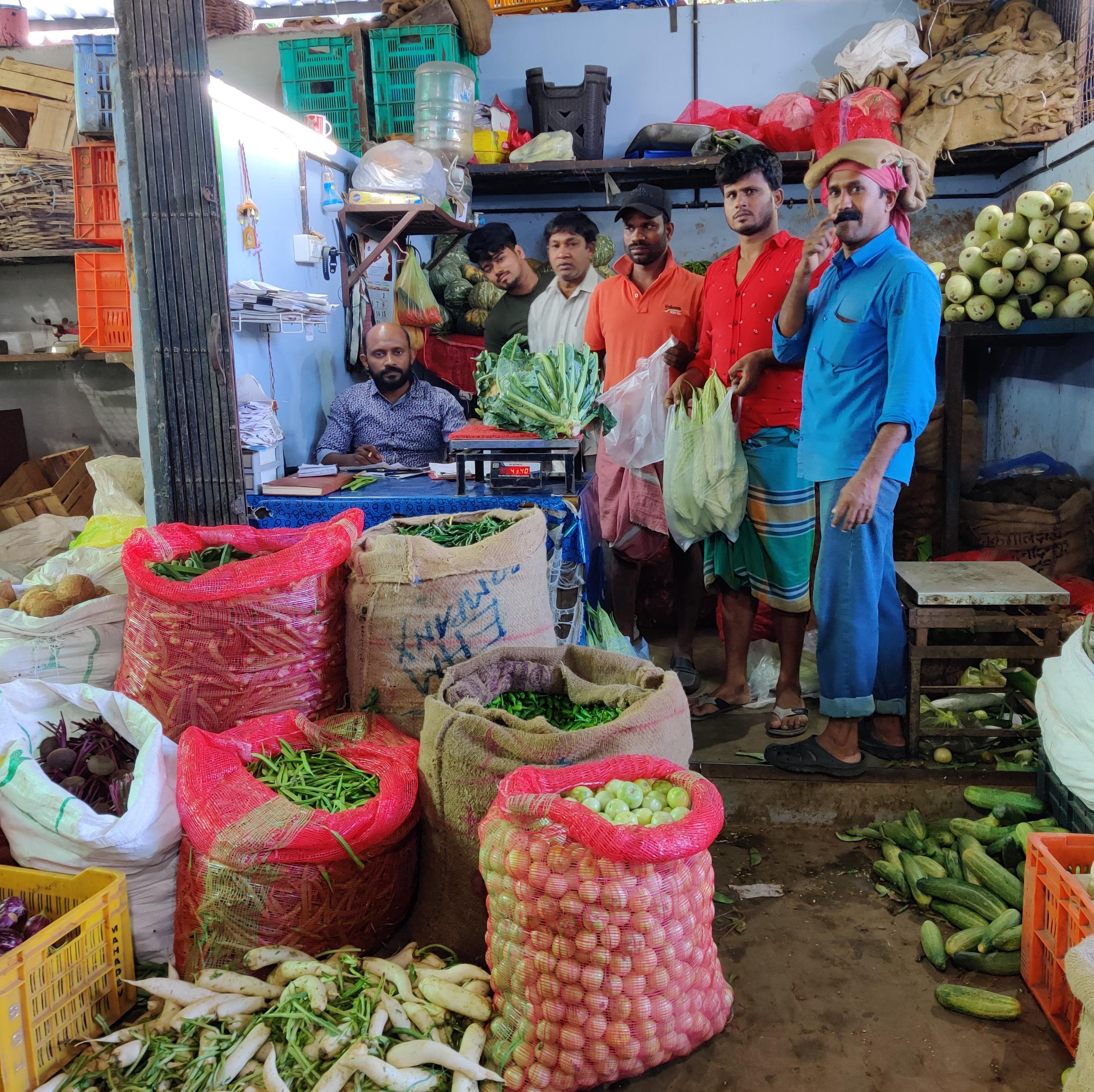
25 Group 1 Fall 2022 24 | Kochi Policies in play - Reclaiming heritage and
in
Market 2.3
livelihoods
Ernakulam
Problem statement
3. Methodologies

There are multiple ways of analysing a site. The tools you use for approaching fieldwork shapes the outcome of the project.
Throughout the project we have been navigating between different methods for each stage of the process: from the research, to the site analysis, to participation and finally, to communicating the project. Some were familiar, some were new to us and had a more experimental character.
Throughout the process we have been moving between observations and understanding We have become aware of that in the process of deepening our comprehension of the context, we become increasingly aware of the complexity.

The process has been a hermeneutic fluctuation between seeing the market as a whole, while at the same time trying to understand separate interactions and processes that take place within this whole (Uxbooth.com, 2015).
Overall, we have been moving from observations to understanding - an inductive approach to knowledge has given us an understanding of general tendencies from the complex whole. However, it is clear that a process is never truly inductive. We arrive at the site with bias and preunderstandings of the context that has shaped our way of approaching the site (Raimo Streefkerk, 2022).
We have been walking, observing, talking, taking pictures, filming, facilitating, and asking questions for two months in Kochi.
This chapter is about the different methods that we have used, and how they have, or have not, been helping us in developing our project.
Deduction
Testing the validity of a theory in reality

A hermeneutic process
A non-linear process of understanding individual parts in themselves, and as a part of a whole.
Ill. 15 - How we were introduced to the context
Induction
Drawing conclusions based on empirical observations
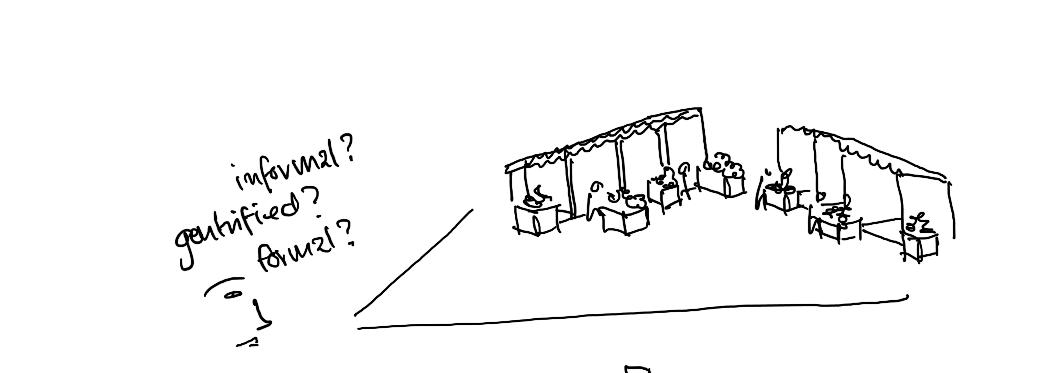
Ill. 16 - How the actual process of analysis went
Ill. 17 - Decoding complexity
27 | Group 1 | Fall 2022 26 Kochi Policies in play - Reclaiming heritage and livelihoods in Ernakulam Market
Unstructured
Semi-structured
Project start August 2022
Departure for Kochi September 2022 SPA Students October 2022


Deskop research
Spatial mapping

Interviews on site


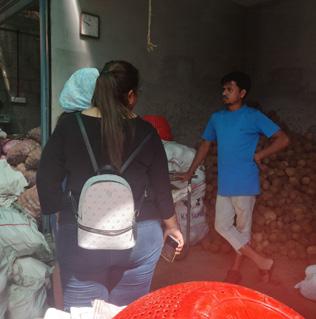
The process was not a linear process. It was a constant overlapping of different phases in the project development.
Ill. 18 - timeline
Stakeholder identification

Problem statement

Stakeholder mapping
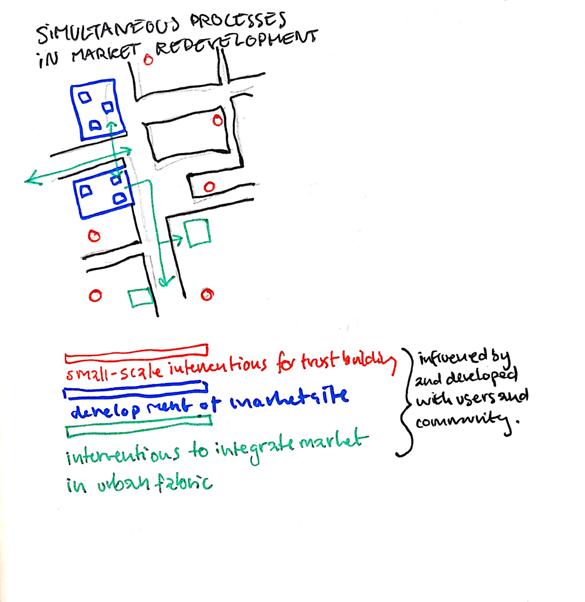


Spatial strategies Co-design
Return to Trondheim November 2022 Finalisation and post-production End of project December 2022 UCT Students November 2022

29 Group 1 | Fall 2022 28 Kochi Policies in play - Reclaiming heritage and livelihoods in
Market
Ernakulam
3.1 Process timeline
What it is
Desktop research, or secondary research, is a process of studying data that is already available. Where primary research is dealing with collecting empirical data first-hand, the secondary research studies other people’s primary research.(Research.com, 2021)


What we did
To familiarise ourselves with the context of Kochi, we studied existing urban plans and literature related to the city and its development. These were plans developed by the municipality, or architecture and urban design projects made by other institutions or student’s work in Kochi. In the process of building our theoretical framework for the project, we studied academic literature related themes of conceptualisation of informality (Altrock, 2018: Recio et al., 2016: Roy, 2009), of insurgent and radical planning(Beard, 2003: Miftarab, 2009), of urban planning (Watson, 2009) and governance structures (Galuszka, 2019).
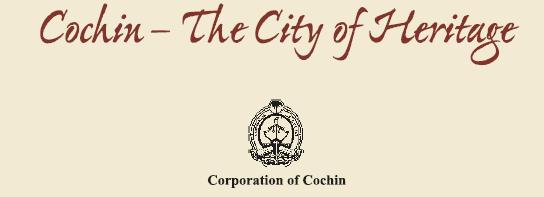

What we thought
The combination of primary and secondary data in the process of building our understanding of the site and the context was essential, and the two methods of gathering information complemented each other in the process. The local communities are most likely not aware of the planning framework that they live as a part of in their daily life in the city. On the other hand, there are aspects of the everyday interactions that take place in the city, which no report or planning proposal will be able to account for.



Ill. 19 - Collage of literature studies

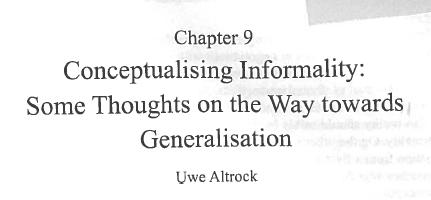
31 | Group 1 Fall 2022 30 Kochi | Policies in play - Reclaiming heritage and livelihoods in Ernakulam Market
3.2 Desktop research and literature studies
What it is
Spatial mapping is a tool for understanding how spatial entities are related to each other in a geographical area It is a process that can consist of both desktop research, by studying maps of the site, in combination with field visits for mapping distinct features and functions on the site. Mapping in itself can be both a part of a process as well as an outcome in itself, depending on what it is needed for. In our case, mapping was used as a processual tool for understanding the context.
What we did
Spatial mapping of the area showed how the market is embedded in a complex network of places and connections. It showed the important relation to the canal and how the canal is both connected to the mainland of Kerala, as well as the Arabian Sea. Furthermore, it gave an overview of important functions in the area, major roads and access points, religious institutions and land-use.
What we thought
The spatial mapping process was interesting for understanding the distinct spatial logic of the site. The combination of studying maps as well as seeing these spatial relations in the field gave an understanding of how the site is situated in the neighbourhood and in the larger urban region. However, the spatial mapping process should ideally have been done in collaboration with the community. In this way, the important features of the area would be highlighted based on the input of people living and working there, rather than based on our interpretation from the outside. As architects and planners we are trained to think and see in a specific way, and this affects how we undertake mappings. Maybe the shop owner would highlight aspects that we would never have thought of?

Ill. 20 - 21 - Spatial mapping
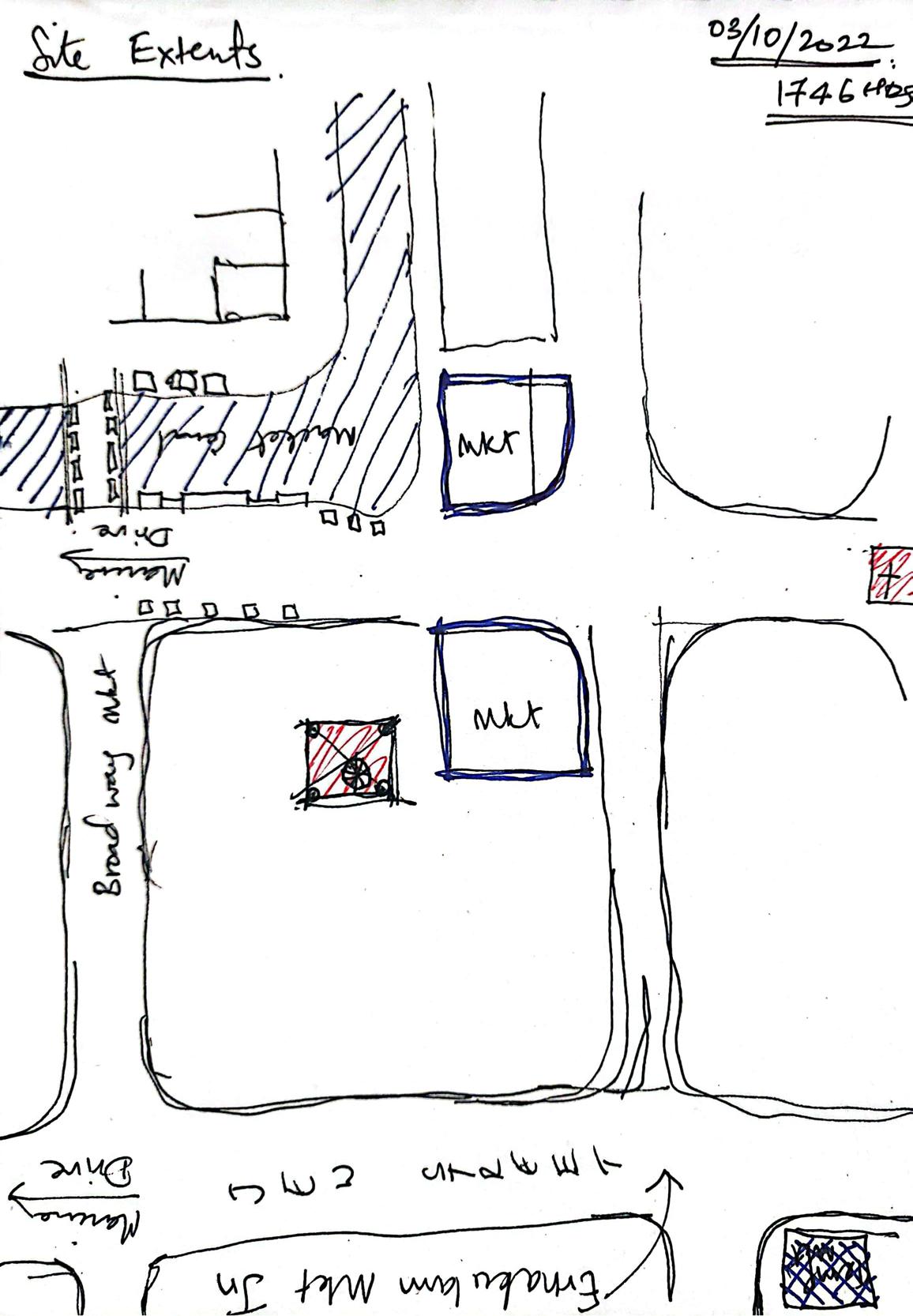
33 Group 1 Fall 2022 32 Kochi Policies in play - Reclaiming heritage and livelihoods in Ernakulam Market
3.3 Spatial
mapping
What it is
A transect walk is a tool for gathering information along a defined trajectory. It is based on “observable” features along a chosen path, for example natural features, landuse, signposting, housing typologies, etc. As you proceed along the path, the feature of analysis is mapped out, according to the location on the path. This allows for studying patterns, tendencies or cause/effect relationships. (Sswm.info, 2019)


What we did
The transect walk was the first mapping exercise we conducted in the field. As a point of entry to understand the logic of the area, we wanted to map the commercial activities along the most central street in the area, Jew Street. The centrality and the busyness of the street was the reason for selecting this street. We walked from the start to the end of the street and mapped the shop typologies. This analysis revealed a pattern of multiple shops with the same products being situated next to each other. Furthermore we recognised a pattern of retail shops being towards the waterfront, and the further away from this area, the more wholesale shops dominated the cityscape.
What we thought
The transect walk was a useful tool as an entry point to the area, and it allowed us to get to know the commercial pattern along Jew Street. However, we only ended up conducting one transect walk, since we wanted to get more in-depth with the socio-spatial structure of the area, rather than doing mapping based on observations. We could have spent more time on the transect walks, however, we were more eager to get in touch with people in the market. This method could be particularly interesting to use in collaboration with the local community.
Ill. 21 - Transect walks
35 Group 1 Fall 2022 34 Kochi Policies in play - Reclaiming heritage and livelihoods in Ernakulam Market
3.4 Transect walks
What it is
Interviews are an efficient tool if you want to understand people’s point of view. In this way, you can get different opinions, perspectives and views of the world explained. The unstructured interview is conducted without a specific interview guide, and is useful to get people talking in an informal setting. The semi-structured interview follows an interview guide, where certain questions have to be answered, but where there is space for follow-up questions or talking beyond the questions. The focus-group interviews include multiple respondents at the same time, and seeks to cover the norms and construction of opinions in a group (122509@au.dk, 2019).
What we did
Most of the information that forms the base of our proposal comes from the interviews we did on site. We heard about the history of the market from individuals, we heard about how it has affected their lives, their livelihoods, how they were not included in the process, etc. What we also experienced from the interviews was a general belief among the vendors and workers that their opinion did not matter. They often tried to point us to more knowledgeable or powerful people, not because they did not want to talk to us, but because they felt unimportant. This experience has informed our proposal.
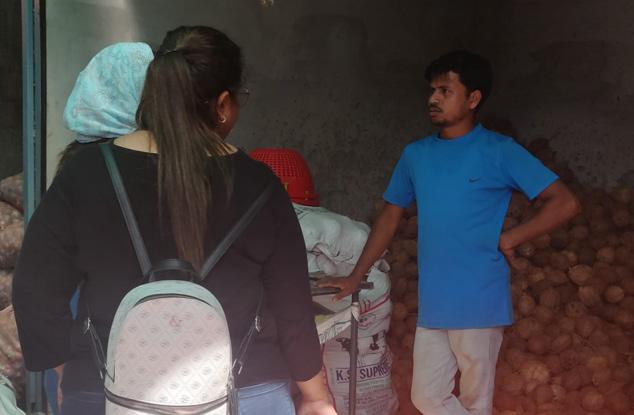

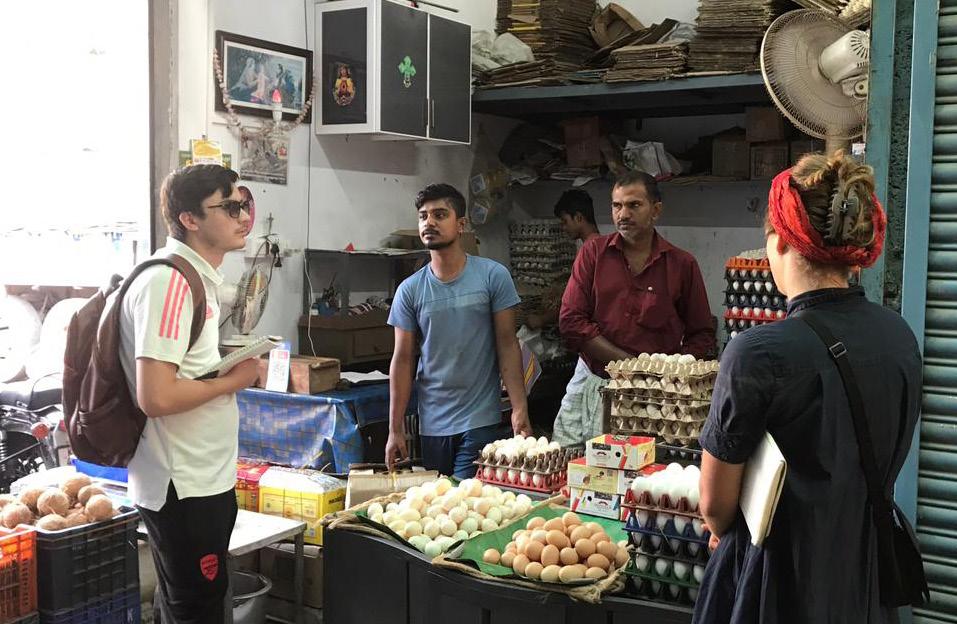
What we thought
The unstructured interview was a good tool for getting involved with the people on site, and was particularly useful as we could get back to the same people multiple times. However, the openness of the interview often resulted in less informative conversations. We introduced the semi-structured interviews to be more specific with regards to the information that we needed. This was helpful, but required a lot of guidance from the interviewer, so the conversation did not also end somewhere beyond the topic. The focus-group interview was conveyed with the union workers, and was useful for us to get an understanding of their perspectives as a group. This form of interview could have been conducted with more of the stakeholder groups, as it would have been useful to have their opinions as a group, rather than drawing conclusions based on individual perspectives.
Ill. 23 - Unstructured interviews
Ill. 24 - Semi-structured interviews
Ill. 25 - Focus-group interviews
37 | Group 1 | Fall 2022 36 Kochi | Policies in play - Reclaiming heritage and livelihoods in Ernakulam Market 3.5 Interviews
Co-production
What it is
Co-production is a collaborative research methodology, where stakeholders are included in the process of forming the agenda, the design, and interpret and integrate the findings. It has the potential to improve the relevance of the research, and include voices that are not usually heard in urban planning processes (Redman et al., 2021).
What we did
In the project we did co-production of maps and co-production of spatial designs. We drew maps in collaboration with the market stakeholders, which allowed us to gain knowledge that would not otherwise be available for us. They based their mapping on stories and memories, and we transferred these stories into spatial entities. The co-production of spatial designs was a process where we developed a series of drafts for shop typologies based on their input, and they gave recurring feedback on these drafts, redrew, and changed them according to their opinion. The idea was that shopowners and workers should be the ones designing their own shops, based on their own needs.
researchers citizens policy-makers
Ill. 26 - Co production is “the triangle that moves the mountain” (Adapted from Tangchareoensathien, 2021)
Ill. 28 - Flyer to hand out in the market
UEP STUDENTS IN ERNAKULAM MARKET
We are Master’s students in Urban Ecological Planning from the Norwegian University of Science and Technology. For our fall semester, we are conducting field work in Kochi, and we are studying the Ernakulam Market as a case.



Urban Ecological Planning is a program that studies cities, communities and how to develop a sustainable future of urban areas.
Ill. 27 - Co production of knowledge (maps)
We are interested in the historical area of Ernakulam and Broadway, in how the current market has changed compared to the former market, and how the new market will respond to the needs of the community.
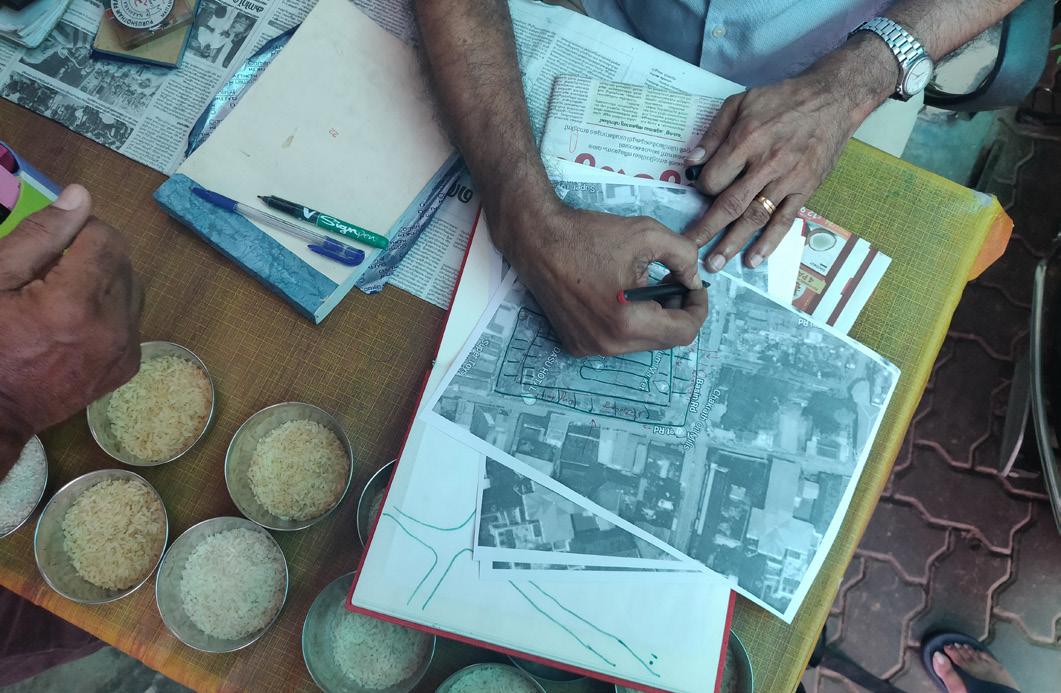
YOU are the day - to day user of the market and YOU are the expert of your community. That is why we are here. We would like to hear your opinions and your stories.
For questions, please refer via whatsapp or email to:
(Student) Stine: +91 9037586103 email: stinkron@stud.ntnu.no or Prof. Gilbert Siame: +260979457414 email: gilbert.siame@ntnu.no
What we thought
A major takeaway from co-producing knowledge and co-designing with stakeholders on the site, is that trustbuilding is a process that takes time We entered the market with no connection to the people in the site, and thus we had to spend a lot of time explaining ourselves. We experienced a high degree of mistrust from the stakeholders, especially the ones with a low degree of power. This resistance could have been reduced with a local gatekeeper with high integrity in the community, who could have shown the people on the site that you are on their side. Based on this, we developed a flyer explaining who we were, and where we came from. In this way we showed integrity and we could, most often, skip a step of explaining ourselves when interacting with people on the site.
Over time, we ended up going back to the people who had been willing to interact with us previously. This resulted in a high reliance on their perspective. This would have been a point of attention if the process was to continue further.
September We are Norwegian we are Ernakulam
Urban and how We are how the and how YOU are and YOU are That is stories. For questions, (Student) or Prof.
Ill. 29 - Co production of spatial designs (below)

39 Group 1 | Fall 2022 38 Kochi | Policies in play - Reclaiming heritage and livelihoods in
Market 3.6
Ernakulam
September 15 November 10 2022
UEP
3.7 Risk assessment and the area-based approach
What it is
A risk assessment is a tool for understanding the vulnerability and the risk in an area, as well as the capacities and assets in the area to respond to the risks. It is useful to conduct as a part of an area-based planning process. The area-based approach is multi-sectoral support in a defined graphical area, including multiple stakeholders, thróugh a participatory process (USWG, 2019).

The area-based approach has the potential to create a platform for collaboration around crosssectoral issues, by bringing together a multitude of actors, building on existing structures and mechanisms, and facilitating a flexible planning process to accommodate for the needs of a diverse range of people (Smith, 2020).
What we did
The risk assessment mapped out and clarified the risk, vulnerabilities, capacities and assets in the market area. It revealed that the area has a strong existing social structure that could be built upon in the planning proposal. The area based approach looked at the market in relation to the surrounding area. To understand the risks that the market is facing this is a crucial approach. Furthermore, the multi-stakeholder approach to the market redevelopment is crucial since the area is highly politicised with a lot of interests across sectors. The area-based approach is in this case useful to avoid conflicts between stakeholders with varying opinions

What we thought
Ideally, the risk assessment should have been done in a more collaborative manner. The information we used for the assessment came from interviews with multiple stakeholders on site, but it could have been interesting to make the assessment as a collaborative process, where multiple stakeholders, in their own words, had to work together around the assessment. We found the area-based approach crucial to integrate as a part of the market redevelopment. In comparison, our evidence shows that the current process facilitated by CSML is looking at the market site detached from the surroundings, which then risks overlooking crucial aspects of the everyday dynamics of the area.
41 | Group 1 Fall 2022 40 Kochi | Policies in play - Reclaiming heritage and livelihoods in Ernakulam Market
Ill. 30
- Risk assessment
Ill. 31 - Processual sketches reflecting the area-based approach



Ill. 32 - Drawing of the shopowner in a bananna leaf stall

43 Group 1 Fall 2022 42 Kochi | Policies in play - Reclaiming heritage and
in Ernakulam Market
livelihoods
3.8 Iterative sketching - the diagram as a tool
Ill. 34 - Process sketch from understanding the spatial constraints and possibilities >

An important part of our process has been to develop the proposal through diagrams and sketches. The diagramming and sketching has been iterative, going back and forth between analysis, ideas and synthesis. Looking at our process through the sketches that we have made as we have proceeded, there is a clear trajectory of iterations that has brought us closer to an appropriate proposal for a planning strategy.
The diagramming has allowed us to visualise the processes that we have imagined. It has helped us to think spatially, converting words into form. It has allowed us to communicate within the group, making sure that we were on the same page when discussing ideas and concepts.
This methodology has reflected an essential idea that has formed our process - that policies related to space can not just be words. There an inherent spatiality and tactility in urban planning that has to be reflected through the process, or as James Corner (2006: 32) says: “A good designer must be able to weave the diagram and the strategy in relationship to the tactile and the poetic.”
Policies can not just be words. Diagrams can illustrate policies related to space.
Ill. 33 - The iterative process where we move back and forth between stages. The final proposal is a point in time but the process could continue through more iterations. Adapted from Hansen and Knudstrup (2005).
44 Kochi | Policies in play - Reclaiming heritage and livelihoods in Ernakulam Market
Ill. 35 - Process sketch to understand scales of interventions, interrelationships between policy and space
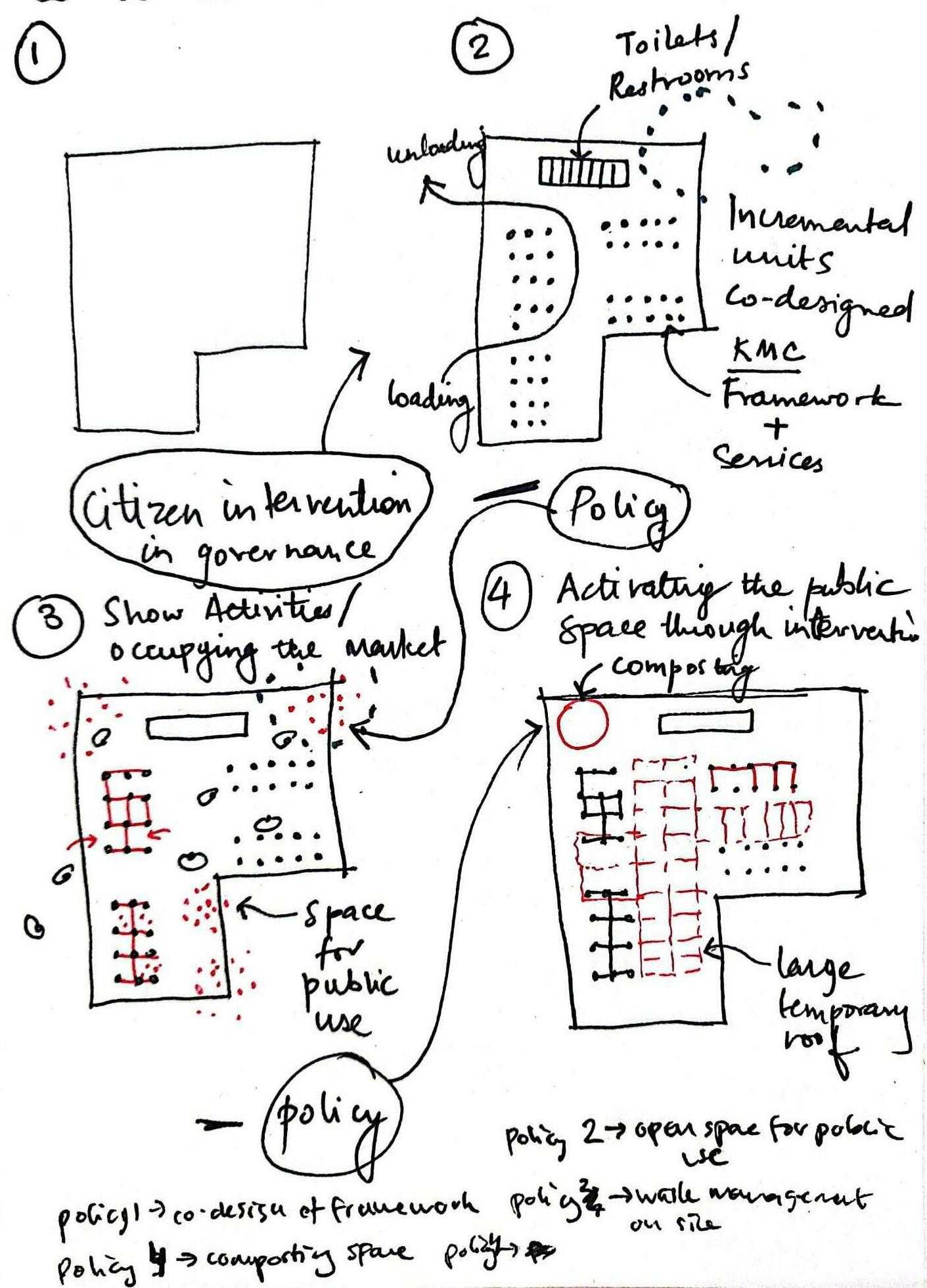


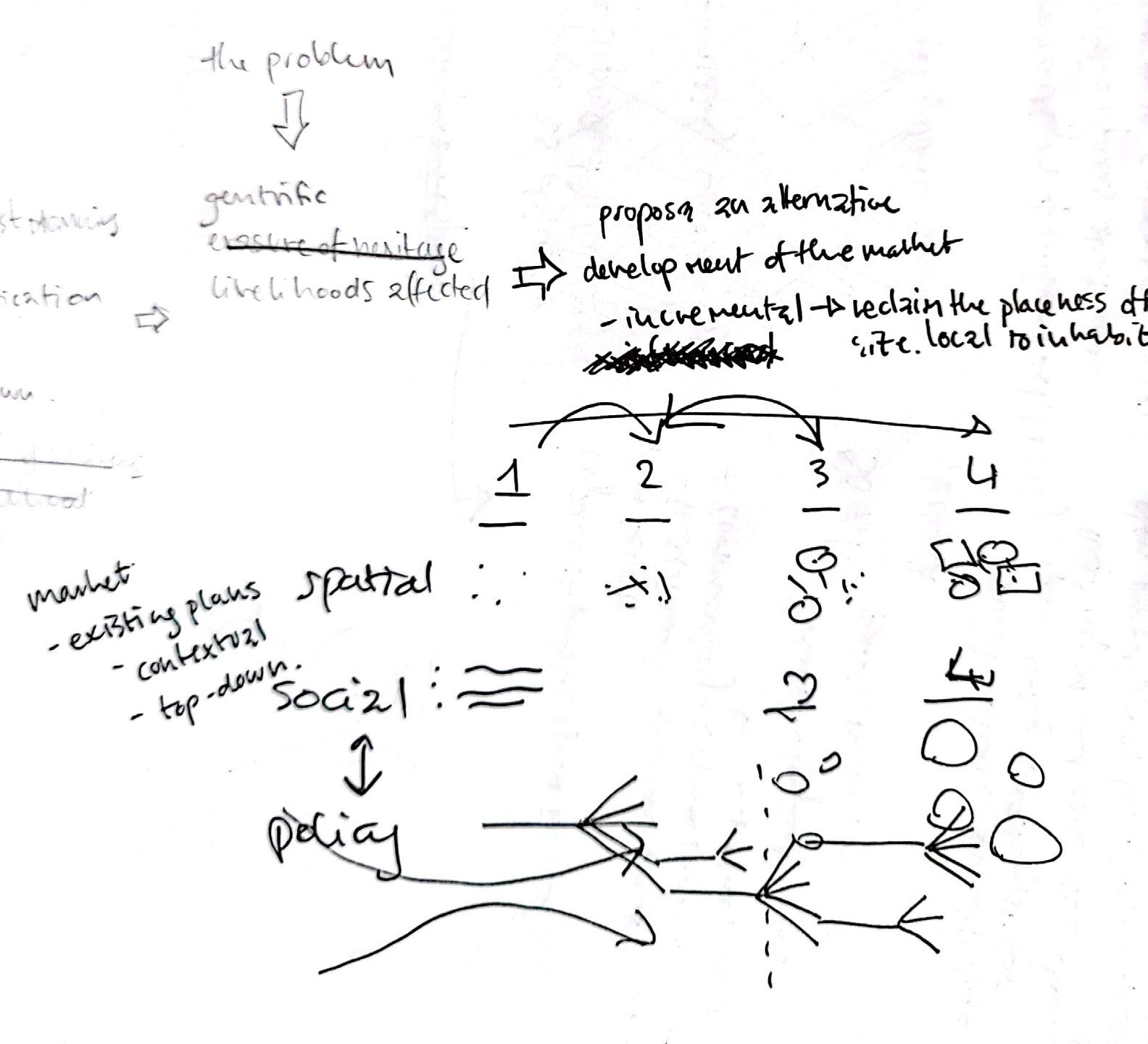
Ill. 36 - Process sketch to gauge the spatial outcomes and their phases
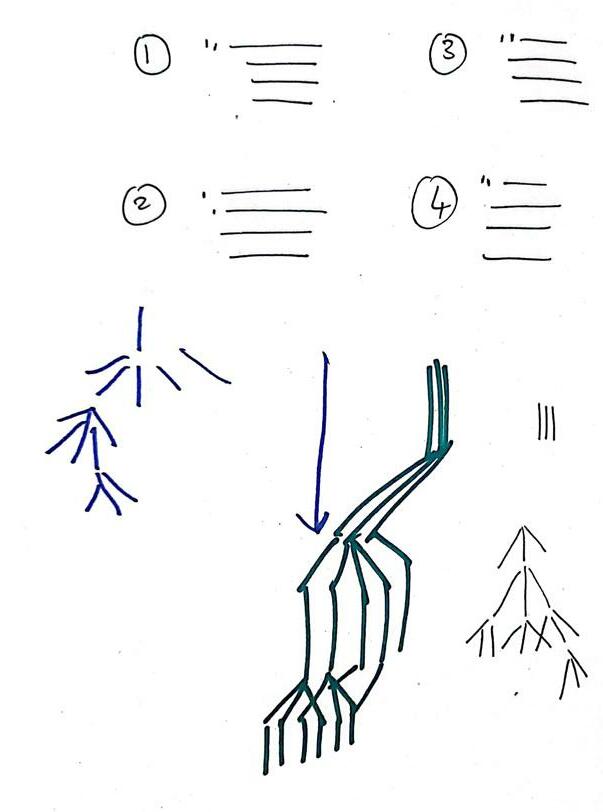
47 | Group 1 Fall 2022 46 Kochi | Policies in play - Reclaiming heritage and livelihoods in Ernakulam Market
Ill. 37 -Above and Right: Process sketch from conceptualising the governance structure


49 Group 1 | Fall 2022 48 Kochi | Policies in play - Reclaiming heritage and livelihoods in Ernakulam Market
Reflection on methods
Participation?
A core aspect of the project that had been stressed from the beginning of the semester, was that we should facilitate participatory processes. The project should be developed with the participation of the stakeholders who are related to the site.
We were introduced to literature that was critically assessing the term “participation”, e.g. White (1996), Arnstein (1969), Galuszka (2019). In the literature, the authors call for a nuancing of the term, to look at what actually takes place in the process, rather than seeing participation as a box that has to be ticked. However, we experienced that this critical assessment of the substance of the participatory practices were missing in the class discussions. It felt like the most important part was to engage with people on the site, but the manner in which we interacted with people was of less importance. Consequently, a large part of the interaction with stakeholders on site was merely extraction of knowledge, and not participation. This is related to what Galuszka (2019: 144) describes as:
“The classic model in which external stakeholders consult the local population has proven to be susceptible to misuse by a wide array of urban actors, starting with public administrations and ending with the community members themselves”.
In the last two weeks in Kochi, we managed to undertake participatory processes, where we co-produced knowledge and co-designed spaces. With more time, this process of actual coproduction would have been more extensive.
There may be many reasons for the limited amount of actual participation. This was the first time in the field for a large part of the class, we spent a lot of time on understanding the context, and
we did not have any gatekeepers to form a bridge between us and the communities. However, we think it is important to be reflective about the processes we are conducting, and the implications of this. Rather than insisting that it was participation, we should call it what it is, because only thus we can critically discuss our processes in order to improve our practices.
Who are the stakeholders?
In our analysis of the stakeholders on the site, we fell into the trap of merely including the people that were present on the site, as well as the powerful institutions that were located somewhere else. This, we have learned, only renders a superficial picture of reality. Since there were only few women on the site, and there were language barriers with the ones that were there, we have not included a single perspective from a woman related to the market. However, this does not mean that women are not affected by the changes related to the market. We left out the entire discussion of gender-related issues because they were “not there”. A major learning from this is that it is simply not enough to include the people who are present on site.
We learned a lot from reading Broto (2021), who writes that queer issues are thought of in isolation from other issues, and are limited to specific topics that heteronormative planning practices expect that they are affected by. This is also applicable to questions of gender in planning. We have to ask: who is not present on the site? And why are they not there? This relates to gender, but also to aspects of intersectionality like age, accessibility, race, religion, etc. If we are to have a truly participatory process, we have to include a broad representation of people in the process.
Ways of seeing – deductive versus inductive analysis
The first point of reflection is concerned with the way in which we approach the analysis of urban situations. Arriving in Kochi with a set of theoretical concepts imprinted in our minds, based on lectures in Trondheim, we were eager to see the city through these lenses. We were advised to look for relevant sites based on concepts of ‘informality’ and ‘gentrification’. However, we were struggling with applying these concepts directly to our observations It felt forced, and this approach gave us a feeling of restricting our way of seeing to look for ‘indicators of informality’ and ‘signs of gentrification’, not being open to observations that fell outside of these categories.
This experience has given rise to a reflection about the methodological approach to analysing urban situations. Do we have a preconstructed understanding that we are seeking proof of (deduction), or will we build our understanding on empirical observations and induce meaning from this (induction)?
As of now, we believe that with a deductive approach there is a risk of applying assumptions and simplifying reality to fit into known concepts. While having a framework for understanding the world may be a useful approach in some situations, we think it is important to be aware of when you look for patterns to fit into your inherent understanding of the world, and to know when to move beyond this way of seeing.
51 | Group 1 Fall 2022 50 Kochi | Policies in play - Reclaiming heritage and livelihoods in Ernakulam Market
3.9
4. Situation analysis
The situation analysis looks at the context, but goes one step further, and tries to understand the issues and relations between people that are not necessarily visible, but requires an interactive dimension in the analysis. It is about networks, relations, and understanding the dynamics of these and how it affects the day-to-day activities on the site.
The data we present is stemming from interviews and interactions with people on the site. First, we talk about the different scales of interactions in the market network, the people that are related to this, and the multi-scalar implications of distorting the market system. Then we show our analysis of how the market is embedded in a network that spans across the country of India. We go in-depth with the stakeholder analysis, and finally, we reflect on the market situation through theoretical frameworks of the formal-informal continuum, and top-down vs bottom-up urban governance.
Ill. 38 - Neighbourhood map of Ernakulam
53 Group 1 Fall 2022 52 Kochi | Policies in play - Reclaiming heritage and livelihoods in Ernakulam Market
4.1 The market across multiple scales

The market is related to activities across multiple scales, ranging from the workers and vendors that are present in the market space, to regions far away from the market space in Ernakulam. People’s livelihoods depend on the day-to-day activities of the market from

the exchange of cash for an apple in the shop, to the nurturing of crops in the agricultural regions where vegetables are grown. Altering the market activities means distorting a complex supplychain system that has evolved through generations.
Ill. 39 - 44 (drawings) Illustrating the different scales of interactions Ill. 45 - 50 (Images) People related to the different scales in which the market operates Ill. 44 - 48



The individual The shop The market
Most of the shops in the market are family businesses that have been inherited through generations. The owners are proud of their shops and are decorated with personal pictures of gods or the grandfathers who founded the shop.
Each shop has one or more employees. Some workers are from Kochi, while others have migrated from distances as far as Northern India. The migrant workers often come in small groups from the same area to seek employment opportunities.


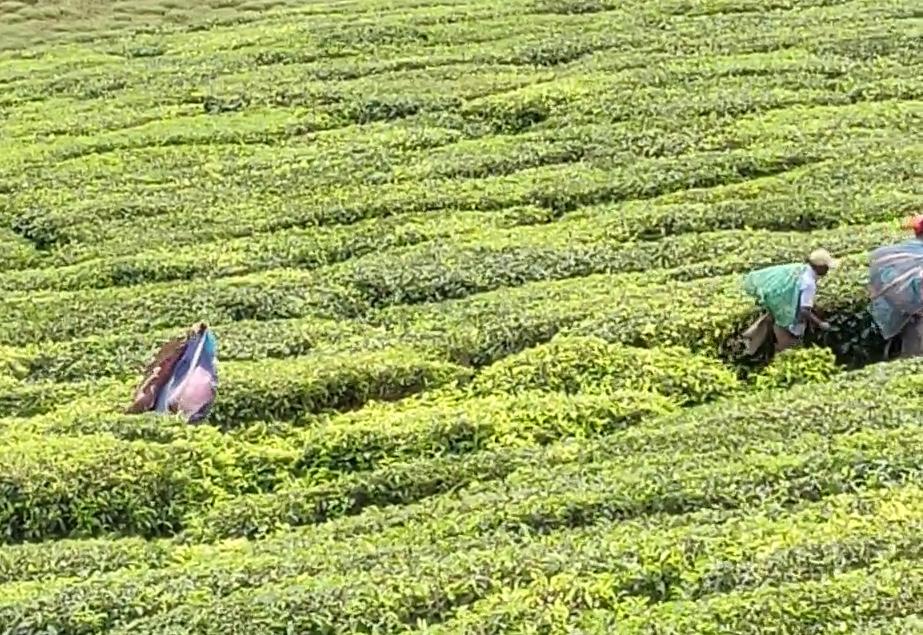


Several strong institutions govern the market. The Market Association links the market to the municipal corporation. The workers who load and unload the trucks belong to a union, and they are visible on site by wearing similar blue shirts.
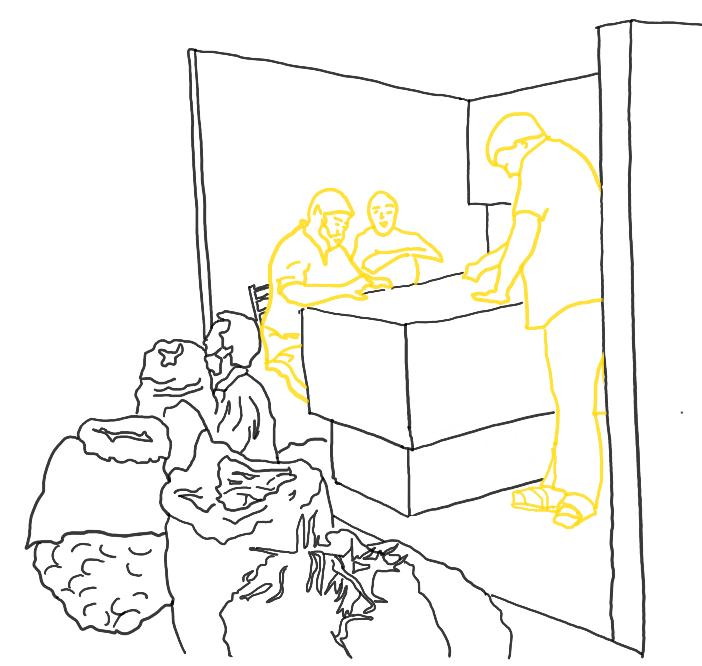
The neighbourhood
The market is embedded in all neighbourhood activities. The vendors and workers take breaks at the surrounding chai stalls. They drink chai and eat snacks. In the picture you see a chai vendor that circulates the market during the day.
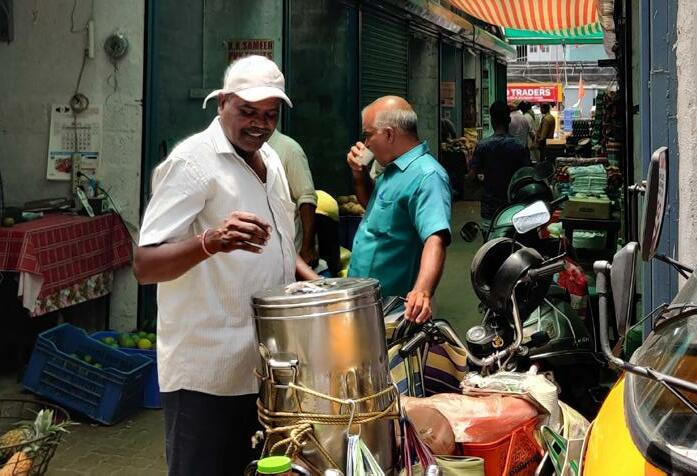
The city The region
Retail buyers from across the city come to the market to buy their vegetables. Tuctucs are loaded with everything from banana leaves to carrots and cucumbers before they head off to hotels, restaurants or smaller retail shops across town.
Spices, vegetables and fruits are being transported from all over the country to Ernakulam with large trucks. The trucks come in multiple times per week. Livelihoods in states as far as Assam and West Bengal depend on the market activities.
55 Group 1 Fall 2022 54 Kochi | Policies in play - Reclaiming heritage
Market
and livelihoods in Ernakulam
4.2 The market and the food-supply chain
The Ernakulam market is a part of a regional food supply-chain. Fruits and vegetables are being transported from a large number of Indian states, to Kochi. Several times per week, trucks arrive with goods from far distances.



Kochi. The market space can not be understood in isolation from the food-supply chain that it is a part of.
This food network implies that changes in the market space, whether that is relocation of the site, less turnover in the day-today activities, or change of the social structure, will affect levels in the supply-chain that are geographically located far away from
In addition to that, the market is also a destination for workers migrating from regions far away from Kerala. Most of the shops have workers that are either hired on a daily basis, depending on what tasks that are needed, or they are permanently employed in the same shop. These workers are from different regions of India, but have come to Kochi for livelihood opportunities. Primarily, the migrant workers are from Northern India.
Fish,
Ill. 53 - Map of states where vegetables are coming from
57 | Group 1 | Fall 2022 56 Kochi | Policies in play - Reclaiming heritage and livelihoods in
Market
Ernakulam
Ill. 51 - 52 - Trucks arriving with goods from far distances to Ernakulam Market
Apples from Kashmir
Various vegetables from West Bengal
Various vegetables from Andhra Pradesh
Dried fish from Odisha
Various vegetables from Tamil Nadu
eggs, pineapples and chickens from Kerala
Onions from Karnataka
Onions from Gujarat
4.3 Stakeholder analysis
The state of Kerala has a distinct political identity. There is a strong history of self-organisation throughout the state. This culture of self-organisation translates to the Ernakulam Market, where several interest groups make up the day-to-day management of the market. The market is a site with a complex network of multiple stakeholders, each with their own agenda. The stakeholders impact each other, however, there is a clear hierarchy when it comes to site-level decision-making. The daily users of the market: the shopowners and the workers, have a low degree of power in decision-making. However, with their livelihoods depending on the market, they have a high interest in the development of the space.
This system of interactions represented in the market site can be understood as a local-scale example of how a top-down governance system works. Interviews on the site have revealed that there is a gap in communication between the different stakeholder groups. The day-to-day users of the space are not being heard in decision-making processes, which results in a lack of representation of what people working in the market on a daily basis actually need.
Stakeholder power-interest analysis
Stakeholders on site
Ill. 54 - The stakeholder power-interest matrix visualises the power each stakeholder has in decision-making, in relation to the interest they have in the development. It is based on Eden and Ackerman (1998: 122). Adapted from Bryson (2004: 30) >
1 - Shopowners (Market)
2 - Retail Buyers
3 - Shopworkers (Market)
4 - Daily-wage Workers
5 - Union Workers
6 - Labour Union
7 - Shopowners (Lanes)
8 - Customers 9 - Market Association 10 - Political Party (CPIM) 11 - KMCC 12 - Local Counsellors 13 - CSML 14 - Local residents
15 - Vendors (Canal) 16 - Truck Drivers 17 - Hawkers 18 - Architects/Planners 19 - Media 20 - KMC
59 Group 1 | Fall 2022 58 Kochi | Policies in play - Reclaiming heritage and livelihoods in Ernakulam Market
Who are the stakeholders?
KMC Local councillor Shopowner (lanes)
Truck driver CSML Local residents Vendors (canal) KMCC
Customers Hawkers Daily-wage workers Retail buyers
61 Group 1 Fall 2022 60 Kochi | Policies in play - Reclaiming heritage and livelihoods in Ernakulam Market
Architects/planners Media Market Association Shopworkers (market) Shopowners (market) Union workers Worker’s union CPI (M) Ill. 55 - Stakeholder drawing
4.4 Stakeholder issue-interrelationships
Through interviews with people present on site, several issues that they were concerned with came up. These are issues such as waste management, congestion of traffic, and increased rent. The issue-interrelations analysis looks at how each stakeholder group is affected by the issues present on site. What is clear is that shopowners and the workers are affected by a multitude of issues. These are also stakeholder groups with a low degree of power in decision-making processes. The organisations with a high degree of power in decision making are not directly affected by the issues present on the site.
Ill. 56 - The issue-interrelations diagram visualises how different stakeholders relate to issues on the site. Based on Bryson 2004, p. 38
63 Group 1 Fall 2022 62 Kochi | Policies in play - Reclaiming heritage and livelihoods in Ernakulam Market
Mapping the stakeholders according to where they are physically based, reveals that most stakeholder groups are present on the market site itself. However, the high-level decision makers, the CSML and the KMC are based in other parts of the city. This de-links decisions from the everyday dynamics of the site. This is symptomatic of the tendency described in the above sections: that there is little connection between decisions made on a high level, and the day-to-day activities in the market.
65 Group 1 | Fall 2022 64 Kochi | Policies in play - Reclaiming heritage and livelihoods in Ernakulam Market
4.5 Stakeholder mapping
Ill. 57 -Based on Marklund-Nagy (2020)
4.6 The formal-informal continuum
Informality was first conceptualised in scholarly work by Keith Hart in 1973, who defined the informal as low-income urban citizens who took part in petty capitalism, substituting wage employment, in order to gain income (Hart, 1973; Recio et al., 2016). Other definitions have related informality to the ability to survive without a job officially recognised by the state (Cooper, 1987), through economic activities that cannot be defined as modern (CoqueryVidrovitch, 1991), and thus relies on small-scale activities existing outside the formal system, in unregulated markets (ILO, 1972). These early conceptions represent a dualistic understanding of the relation between ‘the informal’ and ‘the formal’. In the late 20th century, definitions building on the dichotomous perception of the formal-informal interactions emerged. These were concepts such as “bazaar economies (Geertz, 1963), upper and lower circuits of urban economy (Santos, 1979) and unenumerated sectors (Sethuraman, 1981)” (Recio et al. 2018). However, Jenkins (2001) argues that there is a high degree of acceptance of informal practices in contexts of developing countries and that “the bases of mental models and informal institutions are embedded in the socio-economic and political conditions and are coping with the global North-oriented formal rule of law” (Recio et al. 2018: p. 137). Thus, the structural foundation of the north-south dichotomy is a “subtle expression of a complex web of structural relations” (Recio et al, 2018: 137).
The notion of informality in contrast to formality has not emerged due to the increase of informal practices. What is commonly defined as informal were common practices before the rise of the formal sector, meaning for example institutionalisation of labour in industrialised countries (Portes, 1983). This points to an understanding of informality through the lens of structures and agency (Giddens, 1984), and “how social structures (e.g. economic policies) and human actions (e.g. resistance) shape the causes,
consequences, practices and benefits of informal economic transactions” (Recio et al. 2018: 137)
Through this lens, informality is not a sector that operates in contrast to formal practices. Rather, formal and informal interactions form a continuum where economies, spaces and relations interweave (Roy, 2005; Donovan, 2008; Dovey, 2012). Hence, “the perceived difference between the formal and informal economy is, in reality, artificial in nature. There exists only one national economy with formal and informal livelihood approaches.
The perceived difference lies in the fact that there is a lack of awareness and/or understanding of the mutual dependency of these two aspects of the economy” (ESCR-Asia, 2002). This points to a post-dualistic understanding of informal-formal interactions, where organisational or individual agents respond to what is structurally given (Recio et al., 2018).
In relation to this, Altrock (2018) differentiates between interactions happening in a setting where there are no formal rules, or interactions replacing formal frameworks where they do not work properly. Respectively, these forms of informal practices are conceptualised as complementary and supplementary to formal practices. However, most importantly, Altrock states that “one ought not to speak about a formal-informal divide but rather a hybrid formal-informal arrangement” (Altrock, 2018: 171)
Informal processes within the formal structure of the Ernakulam Market
The study of the Ernakulam Market in Kochi reflects exactly this process of hybrid arrangements of interactions between formal and informal practices.
The market redevelopment is undertaken by KMC, in collaboration with the CSML. These are the formal institutions responsible for the provision of a temporary structure to ensure that the market can retain its commercial activities. The temporary structure that has been provided for the shop owners constitute stalls similar in size and features, a one-size-fits-all solution that does not take into account the required spatiality of each shop for them to retain their livelihoods. What can be observed on the site is that, within the short amount of time that the temporary market has existed, the vendors have modified their shops to accommodate their needs for their shop space. They have broken down walls, built new walls, built attics, installed racks in the ceiling, subdivided or combined stalls, and encroached the surrounding floorspace. The everyday users of the space, the shop owners, have reclaimed agency over their space by modifying their shops outside of the formal structure.
The motive of this behaviour is explained by an owner of a store selling dried fish:
“In the new market, we do not have enough space. It is smaller than what we had before. So we have moved our products out on the street. The space is actually a parking lot, and it is illegal to place anything here, but I don’t care, it makes me sell more. And we are all in the same position, so no one will report this to anyone”
Looking at this through the lens of the structure-agency theory (Giddens, 1984), the framework provided by the KMC is the structure, and the agency is how people respond to this structure. Within this framework, the actions of the shop owners are informal and illegal. However, the state of the shop modifications being ‘informal’ and ‘illegal’ arise only due to the introduction of the formal, ready-made structure of the temporary market space. The process of the shop owners modifying their spaces can further be analysed as a response to the inadequacy of the formal structure to provide sufficient livelihood opportunities for the users. This is what Altrock (2018) referred to as supplementary informality, namely “informal institutions replacing formal ones where they do not work properly” (Altrock, 2018: 171), with the “institutions” understood here as “practices’’.
This process of the shop owners reclaiming agency over their livelihoods by altering their spaces constitute the everyday functionality of the market. The formal and informal practices of the everyday life of the market co-exist and interweave to form a continuum, where the one cannot exist without the other.
67 | Group 1 Fall 2022 66 Kochi | Policies in play - Reclaiming heritage and livelihoods in Ernakulam Market
4.7 Shop typologies
The process of moving the market into a temporary space has implied moving from a spatial logic that has evolved through generations, to a formal structure consisting of units with a uniform spatiality - an 8 m2 (85 ft2), rectangular box.
The temporary market space opened in early 2022, less than a year ago. In this short amount of time, each vendor has modified the spatiality to fit the specific needs of the shop. The vendors make efforts to maximise their livelihoods to make up for the fact that they have less space than previously. The vendors have made informal alterations of the formal physical structure; walls have been broken down, walls have been built, complex vertical storage
Ill. 58 - 63 - The shopowners have modified their shops according to their needs.
systems have been installed and horizontal space beyond the shop area is permanently encroached.
This is a process of the vendors reclaiming agency within the space provided from a top-down process, and due to the temporal character of the current market space, illegal and informal practices are largely overlooked by the governing structures of the space. It is questionable to what degree this practice can take place in the ‘organised, best class shopping destination’ of the future ‘smart-city’ market.
How will this affect the livelihoods of the people of the market?
Some of the shops rent off parts of their space to other vendors, since they have been allocated more space than needed to maintain their business.




The banana shops require a dark storage room and racks from which they can hang bananas. The vendors have built storage space behind their shop and installed racks in the ceiling.

Some shops require only a small space for their counter but a large space to store their goods. These are particularly dryfoods stores where their goods require a lot of space.
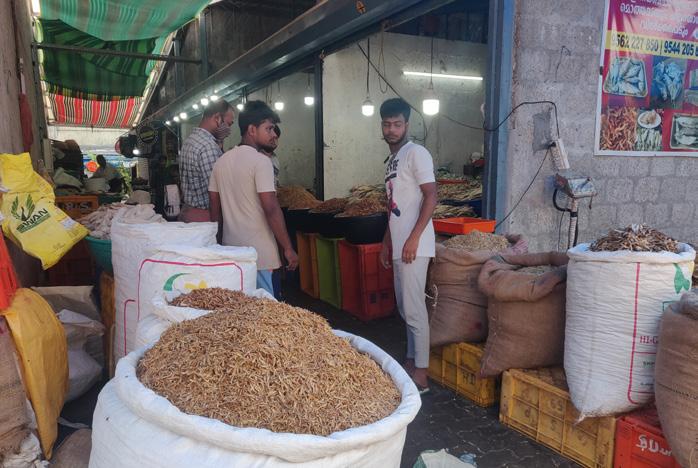
Some shops need permanent walls to showcase products and build altars, while others need the option to combine two adjacent shops by having flexible wall structures.
Many shops have built vertical storage space in the form of shelves or small attics. Each shop has different requirements for the accessibility of the goods stored vertically.
Many of the outermost shops extend their commercial space by encroaching space that goes beyond their shop. This is space that is otherwise designated for on-site parking.
69 Group 1 | Fall 2022 68 Kochi | Policies in play - Reclaiming heritage and livelihoods in Ernakulam Market
4.8 Tabula rasa urbanism
As stated by the CSML, the market redevelopment “...intends to redefine the concept of wholesale market with sophisticated infrastructure and amenities” that is an “organised, highly accessible and best in class shopping destination” (CSML, 2021). The market redevelopment can be seen as a part of a larger process of modernising the city through the narrative of formalising the ‘unsophisticated’ and ‘disorganised’. This is a tendency that can be observed across several cities of the Global South. (Watson, 2009) This narrative is based on westernised ideals of the organised city, stemming from the early 20th century modernist ideals; a narrative that influences southern urban development “through complex processes of colonialism and globalisation” (Watson, 2009: 151). The persistence of planning ideals derived from Western countries suppresses the contextual conceptualisation of cities and planning, resulting in marginalisation of people living lives that do not correspond to the Western assumptions (Watson, 2009).
Within the framework of this critique, urban planning is in itself the root cause of exclusion of certain groups of people. Thus, “urban planning... needs a fundamental review if it is to play any meaningful role in current urban issues” (Watson, 2009: 151)
The neocolonial narrative presents the formal city as the ideal city (Watson, 2009). However, as Roy(2009) states: “the formal and the legal are perhaps better understood as fictions, as moments of fixture in otherwise volatile, ambiguous, and uncertain systems of planning. In other words, informality exists at the very heart of the state and is an integral part of the territorial practices of state power.”
When formalisation sweeps the people away - development for whom?
The process of the redevelopment of the Ernakulam Market reflects


this tendency that ‘the formal city is the ideal city’. A tendency that results in urban planning causing marginalisation of people.
Through the top-down process of moving the market activities from the original site to the temporary site, effects of the gradual process of formalisation can already be observed. As explained earlier, vendors and workers have reported that their livelihoods have been affected by this transition. The formalisation and ‘cleaning up’ the market, transforming it into a ‘modern, orderly’ space and not leaving space for the vendors to inhabit the space on their own terms results in loss of livelihoods of people who did not fit into the ‘box’ of the formal market structure. (insert diagram). The one-size-fits-all does not fit the everyday users of the space.
The market is an example of the issue with formalisation being an end goal in itself. With the effects of formalisation of the market space already affecting the livelihoods of the users in temporary market space, it can be expected that this effect will further increase with the transformation to the new market space that will be “like the Lulu mall” (CSML interview, 2022). One can thus ask:
Who is the new market actually for? Who is the modern city for?
Contextual urban planning means decolonising planners’ imagination by questioning the assumption that every plan and policy must insist on modernisation through formalisation. This mental decolonisation requires recognising how the ideal of the Western city has been deployed historically in the colonial era, and is now deployed in the neoliberal era to advance a certain paradigm of development and capital accumulation. A collective of developers, planners, architects and politicians and a powerful industry of marketing and imagemaking have promoted the Western city as an object of desire (Perera, 1999), or as Watson (2009) puts it: “More of a challenge will be shifting towns and cities away from urban goals and visions that have to do with aesthetics,
global positioning, and ambitions of local elites to replicate American or European lifestyles, to the far more demanding objectives of achieving inclusive, equitable and sustainable cities”(p. 190).
In the interest of retaining existing socio- spatial relationships, livelihoods and characteristics of historic spaces, learning from these contexts along with localising global ideas may be useful and a more appropriate way to upgrade contexts like the urban market. What is evident is that there are “no ready-made solutions for Southern urban contexts” (Watson, 2009: 151) Urban spaces have networks that “transcend municipal boundaries” (Benz, et
Ill. 59 - The temporary market made by KMC Ill. 61 - The market redevelopment is expected to accelerate development in the surrounding neighbourhood.
Ill. 60 - The new market proposed by CSML
al., 2015) and this needs to be acknowledged in decision making processes. Governance structures that overlook planning to be more inclusive, spatially and socially, may help with bringing relevant concerns from the everyday users of the space to the forefront. They often lack a synchronisation of thoughts, common understanding at multiple levels and parameters to measure its trajectories of success and failures over time (Fenton and Gustaffson, 2017). This needs to happen in two ways: inclusive and adaptive policy making and mutual accountability between the communities and the governance structures, both local and state level.
71 | Group 1 | Fall 2022 70 | Kochi Policies in play - Reclaiming heritage and livelihoods in Ernakulam Market
The gentrified city
Gentrification has been and continues to be a cause of concern for various Indian cities today. With the introduction of schemes like the Smart City Mission, technology and results are favoured over people and process, with the aim of making cities ‘smart’. However, is this ‘smart’ city also a city for people? And what are the consequences of a ‘smart city’ relying on technology, when part of the population does not have access to this technology?
The Smart City Mission, conceived by the central government as a way to bring development to Indian cities, adopts the idea to give a makeover to the city by upgrading heritage and culturally important landmarks to ‘global standards’. These changes in the urban fabric, especially in important cultural nodes like the Ernakulam Market, can lead to increasing rents in the overall area, resulting in pushing out the people who can not afford to take part in the urban development
One of the greatest challenges of Indian cities is combating gentrification and protecting the rights of the local communities to their city (Lefebvre, 1968). Protecting and safeguarding communities from gentrification is a difficult but important role of urban planners. However, it is important to note that improvement and upgradation is necessary. Planners have the knowledge and can facilitate positive gentrification of areas. A gentrification without the displacement of the local communities, one that leads to improvement within community infrastructure, aimed at bringing development to the very roots of cities. Afterall, ‘Gentrification without displacement is possible through socially conscious development that honors and recognizes all races, colors, and creeds as a necessary component to revitalization’ (SAA| EVI, BLOG, 2017)
A governance structure capable of including the multiple


layers that make up a city
One of the major challenges in Indian cities today is the correlation between aspirations of an urbanity as perceived by the people in positions of power, namely the government, and the ability to achieve these objectives through contextually relevant policy and urban design initiatives. The study of the Ernakulam Market brings out some key factors that affect the ability to achieve these goals in the Indian context.
Urban challenges are complex to address due to the layering and interrelationships between social and cultural aspects of the context. These aspects coexist and influence each other. To address the complexity of the urban reality a holistic approach to urban planning is necessary, which includes the understanding of the interweaving of formal and informal processes.

The Smart City Mission operates with a one-size-fits-all model, applying the same planning principles to contexts with high variation among them. The Smart City Missions, in the case of Kochi, has a majority of engineers in the team, while there are no urban planners or architects. This leads to a focus on realising the smart city by means of technology through, for example, surveillance and tracking strategies. While these aspects may be important and improve the efficiency of urban systems, this smart city must be embedded in the complex dynamics of the everyday city.
In contrast, this project attempts to look at the layering of issues in society to develop a framework that is capable of taking multiple realities into account when forming urban policies. The images show the early attempts of engaging in this multi-layered understanding of urban issues by layering them. The project argues for the need to look at these issues not in isolation but as a relationship of cause and effect.
Ill. 67 -Development of a governance structure that can include multiple layers and pathways that overlap and intersect (below)
73 | Group 1 | Fall 2022 72 | Kochi Policies in play - Reclaiming heritage and livelihoods in Ernakulam Market
4.9 Reflection
5. Policies in play
Governance and governance systems operate on a mechanism of trust, adaptability and accountability. What the study points out in the case of Ernakulam Market, however, is that there is a lack of trust in the minds of the stakeholders of the market (vendors, workers and shop owners) when it comes to government, administration and the representatives. At the same time those working in the bureaucratic and administrative offices hold the people responsible for a lack of desired outcomes when it comes to implementing policies. This indicates that there are gaps existing in the system that need to be addressed before real change and progress can be made.
The project seeks to relook at the governance system to address these concerns. It looks at rebuilding relationships between the people and the representatives of people to collectively address, monitor and improve situations on ground. This requires a new set of skills in the representatives so that they can listen, learn and cooperate with the people. It needs the people to take responsibility and participate in representing their interests, while at the same time taking responsibility to ensure that they participate and act towards their collective wellbeing. The project assesses a need for both groups to come forward and acknowledge the shortcomings on their end to co-produce a more cooperative system of mutual accountability. This is a system that brings forward positive change in improving governance responses to long standing contextual challenges, what Galuszka (2019) describes as “co-production of governance”.
The proposal focuses on an approach that looks at long-term objectives and that is realised through short term actions. The approach is derived from the “Dynamic Adaptive Policy Framework”(DAPP) (Haasnoot et al, 2019). The aim is to ensure that the governance system adapts itself to a dynamic urban reality and to the needs of the people of the city changing over time. It recognises the need to learn from the way people respond to policy implementation, and assesses the progress it makes to the everyday lives of people. The approach is capable of self-analysing and responding to changing circumstances in an efficient and transparent manner.
In order to do this, it is important to strengthen ties of the administration with the local people, local representatives, citizen groups, associations and corporations. Mobilising a Public Private Partnership can go a long way in achieving a responsive and mutually accountable system of governance.
Ill. 68 - Drawing of the shopowner and the shopworker in a vegetable stall >
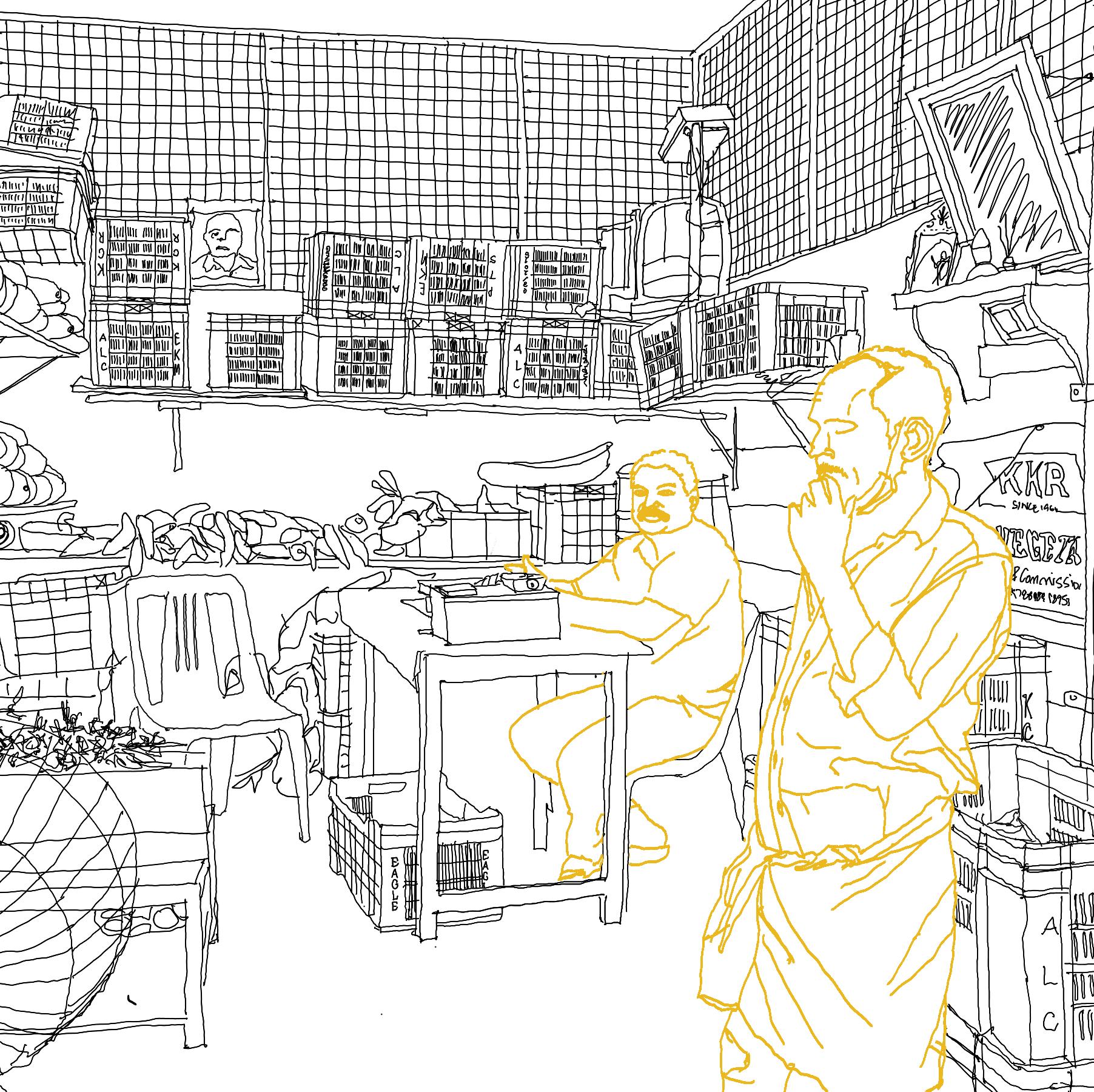
75 | Group 1 Fall 2022 74 Kochi | Policies in play - Reclaiming heritage and livelihoods in Ernakulam Market
5.1 Dynamic Adaptive Policy Pathways
Ernakulam Market is an example of how informal practices take place in a formal structure. The users of the market have organised their spaces and social structures according to what is needed for them in their everyday practices. However, the proposal for the market redevelopment seeks to ‘formalise’ and ‘order’ the ‘disorderlyness’ of the original market. This has implied demolishing the original market, wiping the slate clean, which has resulted in disconnecting the relationships between the built space of the market and the people who have been a part of forming it through generations.
There are similarities between the proposed market design and the ‘Lulu Mall’ of Kochi. With already increasing rents when moving from the original market space to the temporary space, it is expected that this will further increase with the new market development. Effects of this are already seen as shop owners explain that it has been necessary for them to choose between continuing the family owned business or laying off workers. Seemingly small changes in the socio-spatial structure, for example increase in rent, can lead to the shaking of the foundations such spatialities depend on and lead to the collapse of systems that have evolved through generations.
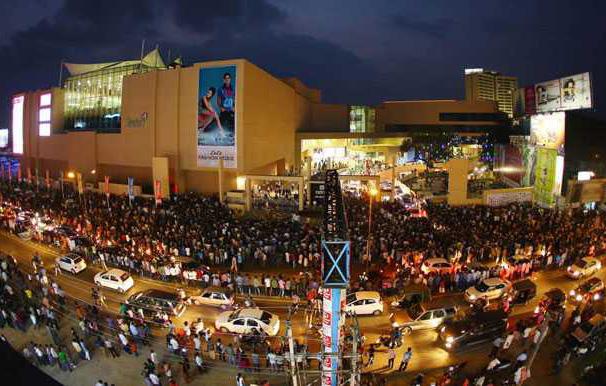
The project seeks to understand that such tendencies are common and realises the potential of governance systems in addressing them. Policy-making with the people at the centre, however, can allow for better opportunities for all stakeholders. This requires a framework that is capable of adapting, analysing and choosing what is best for all concerned groups and collectively making an informed decision on the course ahead. The Dynamic Adaptive Policy Pathway is one such framework. This is an established theory that allows for dynamism in planning, responding to how policies come into play, including decision making over time. The DAPP reflects planning as a trajectory of pathways with multiple
outcomes of short term action as a part of long-term strategies.
The project seeks to look at a governance system where the citizens and municipalities both are responsible for addressing issues and where they hold each other accountable. This helps in rebuilding the trust and of the people in the system. Shared responsibility and accountability creates a space for dialogue.
In the context of Kerala, where self-organisation and forming representative groups to convey and address citizen’s concerns is a common practice, the DAPP strengthens the voices of the people even further.
The DAPP framework addresses objectives that have a long term timeline through short term, incremental and adaptive actions.
Since they are short term actions, they can be adjusted based on changes in situations and adapting to situations that are not anticipated. This can be achieved by bringing together the resources of the government and those of the private organisations and citizen groups.
There are certain key aspects to understanding DAPP:
1. Objectives - these are the main aims that want to be achieved within a certain timeframe.
2. Policy Actions - the objective can be achieved with a combination of these decisions laid down chronologically at specific times
3. Adaptive Tipping Points- this is used to measure the level of success of a policy action. ATPs are a way to change course based on situations that are not anticipated when drafting the original course of action.
4. Soft skills - The proposal also looks at the development of some soft skills that are needed to be able to conduct these processes
Ill. 70 - Diagram adapted from Haasnoot et al (2015)
Ill. 69 - Lulu Mall, Kochi.
in collaboration with the concerned stakeholders of the market (and other such public spaces that have a high dependence on formal-informal structures, and a direct impact on livelihoods). Government officials working with the KMC and organisations such as CSML need to have people with the expertise to deal with complex contexts like the market. An interdisciplinary field of knowledge within decision-making structures is necessary.
77 | Group 1 | Fall 2022 76 | Kochi Policies in play - Reclaiming heritage and livelihoods in Ernakulam Market
5.2 “Adaptive Tipping Points” emerging from the site
Adaptive Tipping Points (ATPs) are indicators for the level of success of a policy action. In a given condition, the impact a new policy has on people, the readiness of the administration to carry it out vary. While it is normal for some level of resistance to change, when there is too much of it, it is an indicator to slow down or change course of action. ATPs are indicators of the ‘right time’ for


these new actions to either be introduced, modified or rethought in order to remain relevant and truthful to the predetermined objectives.
In this project, we look at 4 objectives that have been derived through interactions with stakeholders in the market site.
Objectives Policies to Facilitate Who needs it? Why? What is the significance?
Objective A
Solid waste management
Objective B
Recycling of waste
1. Solid Waste Collection System
2. Circular Economy around waste collection
3. Micro- level point-to-point collection
1. Sorting collected waste
2. Incentives for recycling solid waste (value creation for waste)
3. Facilities for collection, sorting, recycling an reusing
Most stakeholders on the site mentioned waste disposal as a concern. The existing system is insufficient in managing the amount of waste generated from the day-to-day activities. KMC comes twice daily to collect waste, however, it was expressed in the interviews that a better system is needed.
While KMC has been successful in their attempt to make Kochi a binless city, this feat has been achieved in a span of 3 years back in 2010. Since then there have not been attempts to take this forward to the next step of waste sorting. Instead, all the waste collected is dumped at a facility on the outskirts of the city, in Brahmapuram.
5.3 Proposal for a reviewed governance structure
In any society, a state of complacency is achieved when the status quo is maintained for a long span of time. A false sense of ‘comfort’ is generated when governance systems and people do not engage in making available infrastructure and systems better. A trigger is required to change the momentum and bring society on a new trajectory, expanding the prospects of change, leading to evolution.
The diagram below is an interpretation of this journey. A ‘routine’ is set with society being on a specific path or trajectory owing to the governance as it exists. When a new policy or a trigger is introduced, it expands the limits of the society, creating space for a new trajectory to evolve. This forward jump is a small expansion in
the limits of the society, but enough to expand thoughts, ideas and change, until a new status quo is established.
The argument here is that boundaries of imagination, exploration and evolution can be constantly changed and expanded over time. It succeeds when done incrementally and through feedback systems responding to what works and what does not work. Too rapid change at once can lead to chaos, while too little will be non-perceivable. The proposal is based on this premise of introducing change when the stakeholders are ready for it. Incrementality and dialogue become key in maintaining the balance.
Objective C
Livelihoods and entrepreneurship
1. Youth Entrepreneurship programs for waste management and policy- making
2. Pilot programs on ground for waste management and recycling
3. Create Information & Learning centers
Livelihood is one of the most crucial aspects in the market system. Creation of space for existing economic activities as well as creating new opportunities is important. Space creation for these is necessary.
Objective D
Public space
1. Creation of open space on site
2. Multi-functional spaces on site for colearning initiatives
3. Recreational space network in the neighbourhood
There are few public spaces in Kochi. Multifunctional spaces create a diverse set of opportunities for many user groups. These play a key role in maintaining a healthy society by making space for interactions between people of different gender and societal backgrounds.
Ill. 71 - Trajectory of spatial evolution over time and policy triggers for action.
79 | Group 1 Fall 2022 78 | Kochi Policies in play - Reclaiming heritage and livelihoods in Ernakulam Market
5.4 Dynamic Adaptive Policy Pathways- Impact of Objectives and Actions on site Ill. 72 - The DAPP framework translated into the Ernakulam Market redevelopment
81 | Group 1 Fall 2022 80 Kochi | Policies in play - Reclaiming heritage and livelihoods in Ernakulam Market
5.5 DAPP responding to actions on site - alternative trajectory of development
In Ill. 72, Objective A looks at the waste collection system in the market and tries to address the gaps. With each action plan, there is an accompanied policy that facilitates the process. The main aim is to clear up the space that is a large dumpsite in the market for vegetable and fruit waste, along with a small amount of plastic and glass waste. The proposal looks at a scheme of value generation for this waste that could potentially lead to recycling and a circular economy around it. The circular economy is a part of Objective B - recycling of collected waste.The aim with this objective is decentralising the recycling process. This is done with the help of Public Private partnerships, mobilising the existing networks of government and agencies like GIZ who have expertise in this. Collaboration with Kudumbashree (a women empowerment programme across Kerala. Kumar and Jasheena, 2016) workers who can provide people to mobilise it on ground in large proportions.
It is at the intersections of action plans that spatial change happens. Policy-making in itself does not engage with people. Value addition in different ways and providing benefits to the users of the space with each action is necessary for the success of reaching the desired objective in the timeline. The advantage that the DAPP framework allows for is to anticipate people’s needs, but also the flexibility to change, modify and update the actions if desired outcomes are not reached. This gives the community of stakeholders a chance to constantly assess their needs and relay them to the governing body, increasing dialogue between the two agencies. And while the outcome we see in the first diagram is a desired outcome, we now look at what happens in case it needs change.
The second diagram, Ill. 73, looks at the way in which the framework adapts to the needs arising from the stakeholders in the market. This could be different for day and night. An imagined example is the following case, where hawkers claim the open space in the day. At night, once the hawkers leave, it could be used by food carts that cater to the local communities that come for a late night snack. The action plan could then respond to these new activities by designing furniture installations that can adapt to both these activities and also allow it to become a public space when neither of these acts happen. The aim is to open up possibilities and see how the stakeholders respond. We are aware that it is highly possible that the space opened up can be used as a parking space for the different groups in and around the market. The important point here is that, as long as it is a need that arises from the local stakeholders, it can be addressed only with the open minded understanding that any rigid and restrictive policy that takes away control of space from the people will create more resistance to change. The DAPP framework fosters a dialogue between governance organisations and the local stakeholders, rather than a top-down decision making process.

83 Group 1 Fall 2022 82 Kochi | Policies in play - Reclaiming heritage and livelihoods in Ernakulam Market
Ill. 73 - The DAPP framework translated into the Ernakulam Market redevelopment
5.6 Revised stakeholder power-interest analysis
Workers are listened to + owners union slightly more power customers will be included in participatory methods lane shopowners will have more interest since they will want to be included in the process local community more interest and power because of inotrduction of public space. local groups have stronger in uence in deciision making polical party, kmcc, local counsilor power will decrease due to inclusion of other stakeholders in decision making
An essential objective behind the DAPP is the reconfiguration of power dynamics in decision-making. In relation to the proposal for the new governance structure of the Ernakulam Market, an updated power-interest matrix is imagined. What is essential to notice is that the role of the workers and shopowners have changed from being ‘subjects’ to being ‘players’. They have gained influence in decision-making processes related to the market. The worker’s union will gain more power, as they represent the workers
as a collective. The local community and the lane shopowners will have more interest and power since they will be included in the decision-making processes. The power of the CPI(M), KMCC and the councillor decreases as they will have to share power in decision-making with the other stakeholder groups. CSML will decrease in power and interest, however they will still be a context-setter since they will continue to operate in the city and have an interest in its development.
Ill. 74 - Revised stakeholder power-interest matrix (left)
Ill. 75 - Drawing of a vegetable vendor in his shop

1 - Shopowners (Market)
2 - Retail Buyers
3 - Shopworkers (Market)
4 - Daily-wage Workers 5 - Union Workers 6 - Labour Union 7 - Shopowners (Lanes)
8 - Customers 9 - Market Association
10 - Political Party (CPIM)
11 - KMCC 12 - Local Counsellors
13 - CSML 14 - Local residents 15 - Vendors (Canal)
16 - Truck Drivers 17 - Hawkers
18 - Architects/Planners 19 - Media 20 - KMC
85 Group 1 | Fall 2022 84 Kochi | Policies in play - Reclaiming heritage and livelihoods in Ernakulam Market
5.7 Policies in play - market site
Policies can not just be words. To get a sense of how policies affect spacemaking incrementally, we have drawn an imagined trajectory of the market redevelopment. It is important to mention that this proposal is a trajectory of spacemaking, rather than a finished design. If the planning scheme would be implemented, all the inputs for the process will come from co-productive processes with the multiple stakeholders from the market community. They
would be giving input to everything from, in the case of this example, the spatial framework, where trucks would load/unload, what services were needed, what activities that should take place in the open spaces, the order of implementation, the organisation of the shops, etc. For this reason, the diagrams have to be understood as conceptual and not as design proposals.
Ill. 76 - 79 - Diagrams illustrating the how policies come into play in the spatia evolution of the Ernakulam Market
Previous market site Open, unplanned space | Tabula rasa KMC framework and services | Spaces left open | Loading+unloading
Incremental construction and placemaking Policies manifested spatially Open spaces being inhabited spatially
Feedback on policies affecting socio-spatial dynamics | Continuous incremental construction of marketplace and placemaking
The starting point of the process of a new market space is the blank site of the previous market. There are no physical remnants of the market, however, in shared memories in the community the market space remains. A new proposal builds on this memory.
A spatial framework is co-developed by the market community and the KMC. In this way, the space can reflect the needs of the people who use the space on a daily basis. Services and public facilities are provided, and space is left open to accomodate public life.
The framework allows for the people of the market to inhabit, organise, modify and construct the space on their own terms. The process is incremental and reflects the occuring needs of the people who use the space.
As policies manifest themselves socio-spatially, recurring feedback and evaluation mechanisms ensure that the governance of the space adapt to realities of the people using the space. Construction of space is a process rather than a product.
87 | Group 1 | Fall 2022 86 Kochi | Policies in play - Reclaiming heritage and livelihoods in Ernakulam Market
5.8 Shop typologies to fit the everyday needs
Observations and interactions with shopowners in the market made clear that the one-size-fits-all solution that the current (temporary) market is based on, is not adequate for the daily functioning of the individual shops. What we have presented earlier, we have observed insurgent space-making as the shopowner’s response to the inadequacy of the spatial framework that they have been offered.
In the process of imagining an alternative market redevelopment, we interviewed a broad variety of shops about which modifications they had made to their shops, and what their wishes were for a
shop in the new market. As a response to the individual needs that each of the shops had, we drafted a catalogue of modules that the shopowners could choose from. We went back to the market with the drafted modules and took note of which kind of shop that wanted a certain module, and summed up the number of each of the modules that were needed.
The basic unit Basic unit with small storage behind the shop For shops that need to store good in a dark and cool place
What is drawn on this page is the variety of shop modules that came out of this process. This visualises the gap between the diverse range of spaces that are needed, compared to space that is offered in the current market - the first shop typology.
Two adjacent shops with permanent wall For shops that want to showcase on the wall
Basic unit with large storage nearby For shops with need for storage of large goods but who also need a small counter
Ill. 77 - Drawings of different shop typologies based on input from the shopowners and the workers >
Two adjacent shops with flexible wall For shops that are related for example by being owned by the same family
Tall shop with attic For shops with need for storage of goods that are not often needed
Basic unit with adjacent floorspace For shops with need for showcase of goods during the day
89 Group 1 | Fall 2022 88 Kochi | Policies in play - Reclaiming heritage and livelihoods in Ernakulam Market
+
5.9 Possible spatial outcomes
It is inherent in the DAPP framework that the spatial outcome is unpredictable. As urban spaces are processes rather than results, there will never be an ‘’end result’’ in the form of a space with a certain form or structure. Spaces are dynamic and constantly changing.
We have visualised four possible uses of an open space made available through policy-making in the market space, according to the DAPP framework on the previous pages. These visualisations have to be understood as possible outcomes in a moment in time, and not results or permanent states. There are endless possible outcomes to how the city would inhabit an open space. Some uses will have a more public character, like a park or a public space, while others will be serving the few, like a parking lot. According to what is needed among the stakeholders related to the site, the policy framework will respond to the way the space is used.
Ill. 81 - Collage showing the possible outcome of a public space in the market site

90 Kochi | Policies in play -
Reclaiming
heritage and livelihoods in Ernakulam Market
Ill. 82 - Collage showing the possible outcome of a green space in the market site

92 Kochi | Policies in play -
Reclaiming heritage and livelihoods in Ernakulam Market
Ill. 83 - Collage showing the possible outcome of a parking lot in the market site
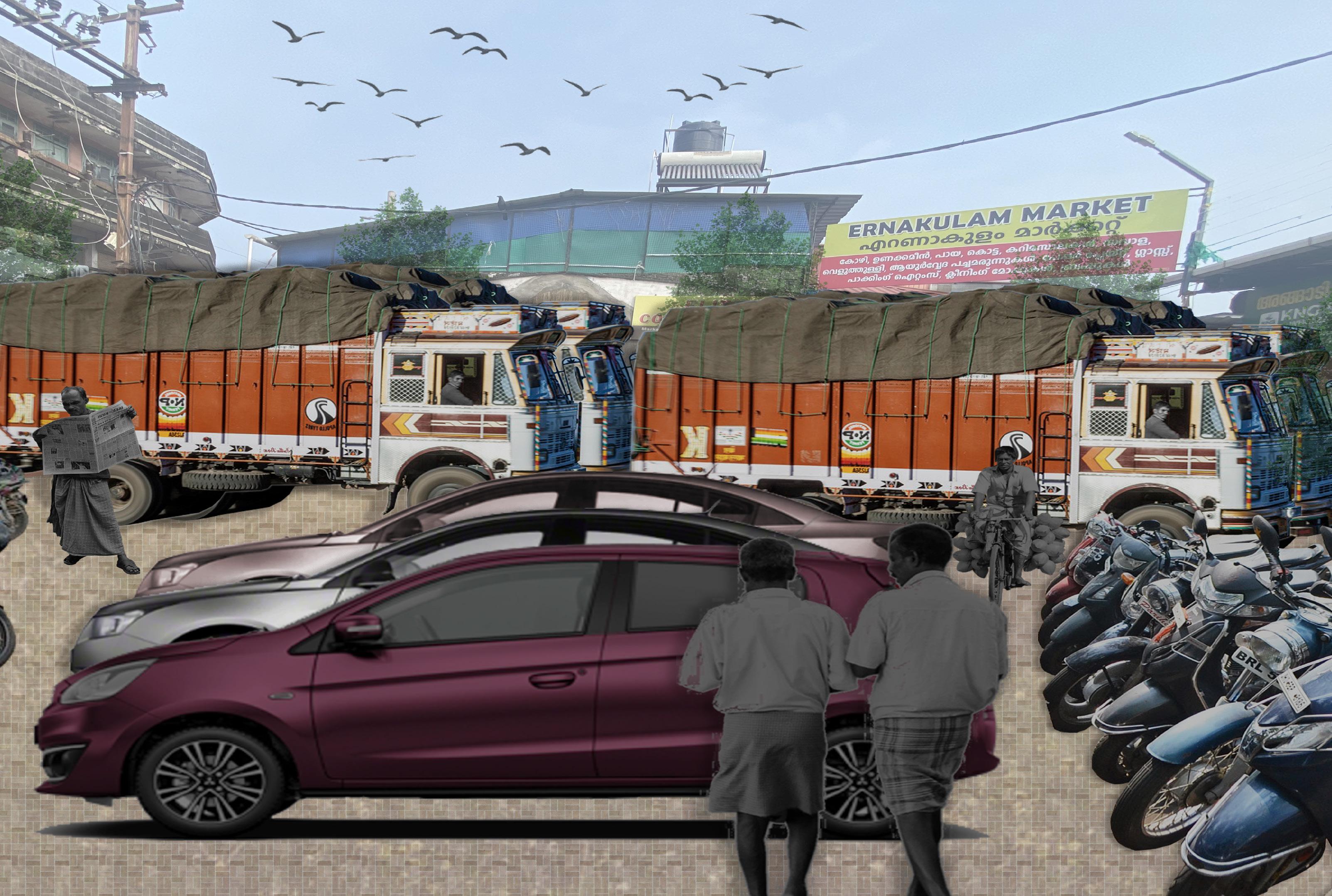
94 Kochi | Policies in play -
Reclaiming heritage and livelihoods in
Ernakulam Market
Ill. 84 - Collage showing the possible outcome of food market in the market site

96 Kochi | Policies in play - Reclaiming
heritage and livelihoods in Ernakulam Market
Reflection
Our entry point to the site was to work with livelihoods in a market context. We quickly learned that a major issue with the current urban development was the loss of livelihoods for people who were depending on the market, and that these people did not have a say in the development process. However, the outcome of the study suggested that loss of livelihoods was a symptom, with the root cause being the governance systems, the urban planning approach and a long term vision that disregards the perspectives of local communities.
While it could have been interesting to specifically look at ways in which current livelihood opportunities in the market could be increased, we went one step deeper and tried to investigate how the planning scheme was causing loss of livelihoods. We analysed a lack of consideration of the delicate structures and relations that the everyday users of the market depend on. In addressing this lack of inclusion of the perspectives of the everyday users of the market, we set out to propose an alternative planning pathway, which understands livelihoods as a complex, dynamic system of interactions. The idea is that people themselves are the experts in what they need in order to sustain their livelihoods. By including as many stakeholders as possible in the planning process, peoples everyday livelihood structures will not be overlooked, but will be taken into account.
We learned that improving livelihood conditions is not a process that can take place in isolation of other planning objectives. Considering people’s livelihoods is an approach that must permeate all aspects of a planning process. This includes acknowledging that people’s livelihoods are a complex system of actions, and that it is “multifarious and dynamic” (Chambers, 1995: 199).

99 Group 1 | Fall 2022 98 Kochi | Policies in play - Reclaiming heritage and livelihoods in Ernakulam Market
Ill. 85 - Drawing of fish shop >
Discussion
The research, fieldwork and the project proposal have led to some important discoveries about the imaginations and understanding that exist in the context of urban developments in India in general and Kochi specifically. These observations and analysis are pertaining to the information collected during the fieldwork from stakeholders on site as well as people working in government institutions like the KMC and the CSML.
Some of the larger initiatives by the CSML are technologically driven, rather than being driven by people and communities. One of the largest projects of the CSML is the Integrated Command, Control and Communication Center (IC4), a high- tech surveillance and information generation system that predicts, cautions and analyses weather, traffic and crime incidents in the city. While this is important, in the larger picture these beckon the question: How is this helping and aiding in the everyday life of the local communities? Can these funds be put to better use to design and plan contextual and communal spaces?
Bureaucracy: a step back from development
The original proposal for the Ernakulam Market renewal was designed by C-HED, the design think-tank funded by the KMC. C-HED comprises a staff that has multi-disciplinary backgrounds with planners, designers, architects, engineers and sociologists working collectively. The ideas proposed as a part of their work titled ‘Broadway and Ernakulam Market Heritage Urban Renewal Project’ (2019) were contextual, comprehensive and grounded with the knowledge of the market and its networks. It took into account aspects like weather conditions, temporality of the market space and informal hawkers, in tandem with the city’s street hawking policy. The project critiqued the common tendencies of mirroring western ideas of development.
The project did not go through in spite of the ground work and budgets being approved.. Instead, the project was handed over to the CSML under India’s Smart City Mission initiative. CSML’s proposal for the market is everything that C-HED has worked to avoid from happening, keeping in mind the people and livelihoods of the market.
These observations bring forward a discussion about which interventions are needed in Indian cities today. While developing cities is important, the timeline in which this is done is of utmost importance. If a small city is suddenly brought forward 10-15 years based on technological advancements alone, it can be catastrophic to local communities who perhaps, require a longer time to adapt to these changes. Livelihoods are lost and informal economies are the most affected with such rapid changes to the city’s infrastructure and development. Most often, the communities affected are the natives of the land whose humble houses get replaced by high rise gated community projects and in this case, a local market gets gentrified when converted into a shopping mall with multilevel parking and sky walks. The larger conversation here is about the notions of heritage in public space planning in the country.
Technological city versus developed city
CSML is an urban body funded jointly by the state and the central government. The Smart City initiative was formed with the idea to develop more Indian cities and contribute to the economy of the city. The aim was to use technology to bring India to the global level of development and make cities capable of handling the pressures of urbanisation. However, the technological aspect has overshadowed the urban development aspect. With the offices largely employing engineers in Kochi’s scenario, ideas of surveillance and providing technical support to the city takes precedence over the organisation’s capacity to provide grounded, contextual planning and policies that benefit the local communities and economies.
The idea of heritage in public space planning and its implications
‘‘We are constantly faced with the conflict of conserving and protecting heritage on one hand, and addressing the living and economic needs of our huge population on the other hand.’’ (C-HED, 2019). The CSML has designed the new Ernakulam Market “like the Lulu Mall”(CSML, 2022). In order to do this, the old, dilapidated market structure was demolished and shops were moved to a temporary location in the neighbourhood not very far away. The ‘temporary’ market structure is made using bricks and steel, and has been claimed and appropriated by the shop owners to now become a fully functional market. While some elements of the ‘heritage’ of the old market have been included in the form of the roof design, the nature of the spaces of the mall are clinical, very different from the old market. With rents already surging since the demolition, it brings concerns of the new market being the foundation stone in gentrifying the entire Ernakulam and Broadway district. It brings into question who benefits from this development.
101 Group 1 Fall 2022 100 Kochi | Policies in play - Reclaiming heritage and livelihoods in Ernakulam Market
Conclusion
Cities are dynamic spaces with multiple realities overlapping and interchanging. The city changes faces every day and development of everyday practices evolve over long spans of time. Our heritage reminds us about how things have changed over time. It reminds us that the world changes, and encourages us to question whether things were better before, or if we want to continue the trajectory of change.
With the introduction of modernism as vision in the early 20th century, there was an urge for a collective restart, to build the future city of our dreams. However, with modernist ideals changing western cities at a rapid speed, critical voices began to address the lack of inclusion of people in urban planning schemes. Modernist city ideals now belong to the past in many parts of the world. While this is the case in many western cities, many cities in countries of growing economies continue to adopt modernist visions as the picture of the future ideal city. This can be seen as remnants of colonial practices, where imperial countries have imposed ideals derived from Northern assumptions into a context where the urban reality looks remarkably different (Watson, 2009). The consequence? Urban planning schemes meant to cater for a certain lifestyle, gentrifying cities by pushing out the people who cannot afford to be a part of this development.
Through this lens, the Ernakulam Market redevelopment in Kochi has been analysed. It was a space that had evolved through generations as a part of a distinct spatial heritage in the urban area of Ernakulam. Through a development scheme proposed by the Smart Mission Limited, the original market has been demolished, and a new scheme is proposed. The new is presented as an “organized, highly accessible and best in class shopping destination” (Csml.co.in, 2021). In the meantime, the market activities have been moved to a temporary space. In this report, it has been questioned: How will the redevelopment of the Ernakulam Market affect the day-to-day activities of the market, the livelihoods, and the already ongoing gentrification of the community of Ernakulam?
With a combination of primary and secondary research methodologies, the effects of the market redevelopment on the community that is connected to the space has been investigated. The development process has been analysed through theoretical frameworks of the formal-informal continuum (Altrock, 2018: Recio et al., 2016: Roy, 2009), of insurgent and radical planning(Beard, 2003: Miftarab, 2009), of urban planning (Watson, 2009) and governance structures (Galuszka, 2019).
The research findings indicate that there has been a loss of livelihoods in the process of moving the market from the original market to the temporary space, due to a distortion of the market system. The market redevelopment process has been made in disregard of the day-to-day practices of the market Furthermore, the interviews revealed a large insecurity among the people in the market, related to the current development. They did not consider themselves as important stakeholders in the process. The market community saw themselves as passive subjects in the decision-making process, relying on someone else in a higher position of power to make decisions for them.
In response to the linear urban development process taking place in the market redevelopment, this report proposes an alternative planning pathway. This has been developed through co-design processes with the market community, and builds on a need to adopt a planning scheme that considers multiple realities simultaneously. An urban planning scheme that includes multi-stakeholder decision-making over time, where policies and actions are made in accordance with the urban reality.
The proposed scheme builds on an existing theory of Dynamic Adaptive Policy Pathways (Haasnoot et al., 2019). The redevelopment of the Ernakulam Market is imagined through the DAPP framework, based on the current situation of the market having been demolished. The planning framework of DAPP allows for an incremental process of redevelopment, including multiple stakeholders from the market, and allows for the site to reconnect with the surrounding urban area.
If urban planning is to respond to the issues and urgencies arising from rapid urbanisation, it must take into account the realities of the everyday practices of the city. Cities are dynamic processes that have to be approached through similarly dynamic planning schemes. With westernised, linear planning models imposed into contexts with high degree of formal-informal interrelations, there is a risk of overlooking the networks that the urban everyday processes depend on. One can ask - development for whom? In Kochi, the market redevelopment is one example of a topdown planning idea applied to an urban area with a fine-grained network of everyday practices. However, this is not a tendency limited to Kochi. It is a global tendency that must be addressed, or, as Watson (2009: 151) writes: “Urban planning ... needs a fundamental review if it is to play any meaningful role in current urban issues’’ (Watson, 2009: 151)
103 Group 1 Fall 2022 102 Kochi | Policies in play - Reclaiming heritage and livelihoods in
Market
Ernakulam
Altrock, U. (2018) Conceptualising informality: Some thoughts on the way towards generalisation. Urban Informalities: Reflections on the Formal and Informal. 171-189.
Beard, V. A. (2003) Learning radical planning: The power of collective action. Planning Theory, 2(1), 13-35.
Benz, Arthur, et al. (2015) The trans-local dimension of local climate policy. Sustaining and transforming local knowledge orders through trans-local action in three German cities. Urban Research & Practice 8.3 (2015): 319-335.
Broto, V. (2021) Queering participatory planning, Environment & Urbanization, 2021, International Institute for Environment and Development (IIED). Vol 33(2): 310–329.
Bryson, J. M. (2004) What to do when stakeholders matter: stakeholder identification and analysis techniques. Public management review, 6(1), 21-53.
Chambers, R. (1995) Poverty and livelihoods: whose reality counts? In Environment and Urbanization (Vol. 7, Issue 1).
C-HED (2019) Broadway and Ernakulam market urban renewal project, Centre for Heritage, Environment and Development, Kochi.
CIAM (1933) La Charte d’Athenes or The Athens Charter Congress Internationaux d’Architecture moderne, Trans J.Tyrwhitt. Paris, France.
Cooper, F. (1987) On the African waterfront: Urban disorders and the transformation of work in colonial Mombasa. New Haven: Yale University Press.
Coquery-Vidrovitch, C. (1991) The process of urbanization in Africa (from the origins to the beginning of independence). African Studies Review, 34(1), 1–98
Corner, J. (2006) Terra Fluxus. The landscape urbanism reader, 21-33.
Csml.co.in. (2021) Redevelopment of Ernakulam Market – CSML. [online] Available at: https://csml.co.in/redevelopment-of-ernakulam-market-2/ [Accessed 7 Dec. 2022].
CSML (2022) quote from meeting with CSML in their office, Kochi 02.11.22.
Donovan, M. G. (2008) Informal cities and the contestation of public space: The case of Bogotá’s street vendors, 1988–2003. Urban Studies, 45(1), 29–51.
Dovey, K. (2012) Informal urbanism and adaptive complex assemblage. International Development Planning Review, 34(4), 349–368.
Economic, Social and Cultural Rights – Asia (2002) A compilation of initiated and jointly undertaken studies of ESCR-Asia on economic, social and cultural rights in the informal sector. (Quezon City, Philippines)
Eden, C., & Ackermann, F. (1998) Strategy making. London: Sage.
Geertz, C. (1963) Peddlers and princes: Social development and economic change in two Indonesian towns. Vol. 318, Chicago: University of Chicago Press.
Giddens, A. (1984) The constitution of society: Outline of the theory of structure. Berkeley: Polity Press
Haasnoot, et al. (2019) Dynamic adaptive policy pathways (DAPP). In Decision making under deep uncertainty (pp. 71-92). Springer, Cham.
Hansen, H. T. R., & Knudstrup, M. A. (2005) The Integrated Design Process (IDP): a more holistic approach to sustainable architecture. In Action for sustainability: The 2005 World Sustainable Building Conference (pp. 894-901). Tokyo National Conference Board.
Hart, K. (1973) Informal income opportunities and urban employment in Ghana. The journal of modern African studies, 11(1), 61-89.
International Labour Organization (ILO) (1972) Employment, income and equality: A strategy for increasing productive employment in Kenya Geneva: International Labour Office.
Jenkins, P. (2001) Regularising “informality”: turning the legitimate into legal? Land reform and emerging urban land markets in post-SOCIALIST Mozambique, paper prepared for the N-AERUS workshop, Leuven, May 2001 on “coping with informality and illegality inhuman settlements in developing cities”.
Kumar, A., & Jasheena, C. J. (2016) Kudumbashree: Promoting the self-help group model of empowerment through women entrepreneurship in Kerala - a study. Prabandhan: Indian Journal of Management, 9(6), 20–34. https://doi. org/10.17010/pijom/2016/v9i6/94959
Lefebvre, H. (1968) Le droit à la ville. París: An.
Marklund-Nagy, E. (2020) Stakeholder Mapping, Module 4: AAR4820 Methods and Reflections, Urban Ecological Planning, Norwegian University of Science and Technology, recorded 17.09.2020
Menon, B. (2022) Cochin: History and Heritage, presentation 03.10.22, Abad Plaza, Kochi
Miraftab, F. (2009) Insurgent planning: Situating radical planning in the global south. Planning Theory, 8(1), 32–50. https://doi.org/10.1177/1473095208099297
Pallasmaa J (2009) The thinking hand: existential and embodied wisdom in architecture. Chichester: Wiley.
Perera, N. (1999) Decolonizing Ceylon: Colonialism, Nationalism and the Politics of Space in Sri Lanka. Oxford: Oxford University Press
Portes, A. (1983) The informal sector: Definition, controversy, and relation to national development Review, 7(1), 151–174
Raimo Streefkerk (2022) Inductive vs Deductive Research Approach (with Examples). [online] Scribbr. Available at: https://www.scribbr.co.uk/researchmethods/inductive-vs-deductive-reasoning/ [Accessed 2 Dec. 2022].
Recio, et al. (2017) Revisiting policy epistemologies on urban informality: Towards a post-dualist view. Cities, 61, 136-143.
Redman et al. (2021) Co-production of Knowledge Collection Steering Committee. Co-production of knowledge: the future. bmj, 372.
Research.com. (2021) Research as a discipline employs a wide variety of methods Available at: https://research.com/research/primary-research-vssecondary-research#secondary [Accessed 5 Dec. 2022].
Roy, A. (2005) Urban informality: Toward an epistemology of planning Journal of the American Planning Association, 71(2), 147–158.
Roy, A. (2009) Why India cannot plan its cities: Informality, insurgence and the idiom of urbanization. Planning Theory, 8(1), 76–87. https://doi. org/10.1177/1473095208099299
Santos, M. (1979) The shared space (translated from Portuguese edition (1975) by Chris Gerry). London and New York: Methuen. Sethuraman, S. V. (1981) The urban informal sector in developing countries: Employment poverty and environment Geneva: International Labour Office. Smith, D. (2020) Area Based Approaches, Module 4: AAR4820 Methods and Reflections for Studying Urban Informality, Urban Ecological Planning, Norwegian University of Science and Technology, recorded 21.10.2020, https:// ntnu.cloud.panopto.eu/Panopto/Pages/Viewer.aspx?id=669f6542-1f7f-4aa8-a937adaa00c6a40f
Sswm.info. (2019). Transect Walk, Available at: https://sswm.info/ humanitarian-crises/urban-settings/planning-process-tools/exploring-tools/ transect-walk [Accessed 2 Dec. 2022].
Tangchareoensathien (2021) Co-production of evidence for policies in Thailand: from concept to action in this collection. BMJ2021;372:m4669. doi:10.1136/ bmj.m4669
USWG, (2019) Area-based approaches in urban settings. Compendium of case studies. Urban SettlementsWorking Group and Global Shelter Cluster. Uxbooth.com. (2015) Hermeneutics for Designers UX Booth. [online] Available at: https://www.uxbooth.com/articles/hermeneutics-for-designers/
[Accessed 2 Dec. 2022].
122509@au.dk (2019) Interviews. [online] Metodeguiden.au.dk. Available at: https://metodeguiden.au.dk/interviews [Accessed 4 Dec. 2022].
Watson, V. (2009) The planned city sweeps the poor away: Urban planning and 21st century urbanisation, Progress in Planning, Volume 72, Issue 3, Pages 151-193
List of figures
All drawings and pictures are produced by the authors except the following:
Ill. 10 - Thehindu.com. (2013). The quaint Ernakulam bazaar. [online] Available at: https://www.thehindu.com/features/friday-review/ history-and-culture/the-quaint-ernakulam-bazaar/article4630327. ece [Accessed 10 Dec. 2022].
Ill. 13 - Paul, J.L. (2022). Ernakulam market complex to be ready for commissioning by February 2024. [online] Thehindu.com. Available at: https://www.thehindu.com/news/national/kerala/ernakulam-market-complex-to-be-ready-for-commissioning-by-february-2024/article66125327.ece [Accessed 10 Dec. 2022].
Ill. 64 - Express News Service (2021). Market makeover for Ernakulam under Cochin Smart Mission Limited... [online] The New Indian Express. Available at: https://www.newindianexpress.com/ cities/kochi/2021/oct/21/market-makeover-for-ernakulam-undercochin-smart-mission-limitedarket-makeover-2373729.html [Accessed 10 Dec. 2022].
Ill. 69 - Radhakrishnan, M.G. (1999). Rupee Windfall: While India reels from a currency slide, Kerala revels in a remittance deluge. [online] India Today. Available at: https://www.indiatoday.in/magazine/society-and-the-arts/story/20130923-india-reels-from-currency-slide-kerala-revels-in-a-remittance-deluge-767686-1999-11-29 [Accessed 10 Dec. 2022].
105 Group 1 | Fall 2022 104 Kochi | Policies in play - Reclaiming heritage and livelihoods in Ernakulam Market
References


 Policies in Play - reclaiming livelihoods and heritage in the Ernakulam Market Ernakulam | Kochi | Kerala | India
Policies in Play - reclaiming livelihoods and heritage in the Ernakulam Market Ernakulam | Kochi | Kerala | India



































































































